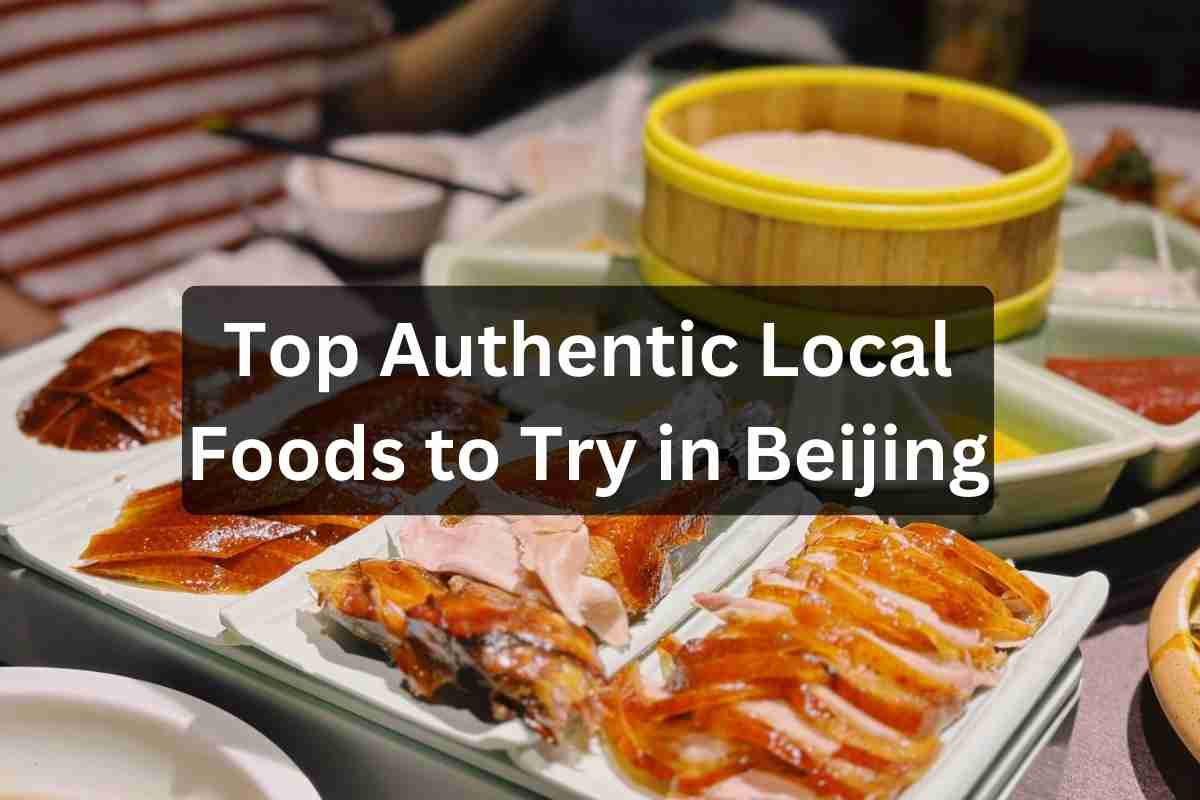As a bustling capital with over 3,000 years of history, Beijing offers visitors an abundance of incredible sights and cultural experiences.
But for many travelers, it's the food that leaves the most lasting impressions. Beyond the tourist staples, Beijing is home to a thriving food scene bursting with mouthwatering authentic local eats.
So discard your takeout menu, put down the panda-shaped souvenir mug, and get ready to tantalize your taste buds.
This local's guide will take you on an eating adventure through 18 of Beijing's tastiest, most authentic foods that you simply must try.
From juicy dumplings to aromatic hot pot, crispy Peking duck, warming noodle soups, and beyond, prepare for a feast of time-honored flavors the locals love.
Just don't forget to bring your appetite – because our city's amazing authentic eats should be on every visitor's Beijing bucket list!
Let's dig in to the real culinary treasures of China's capital!
Essential Dishes You Must Eat in Beijing
1.Peking duck – 北京烤鸭
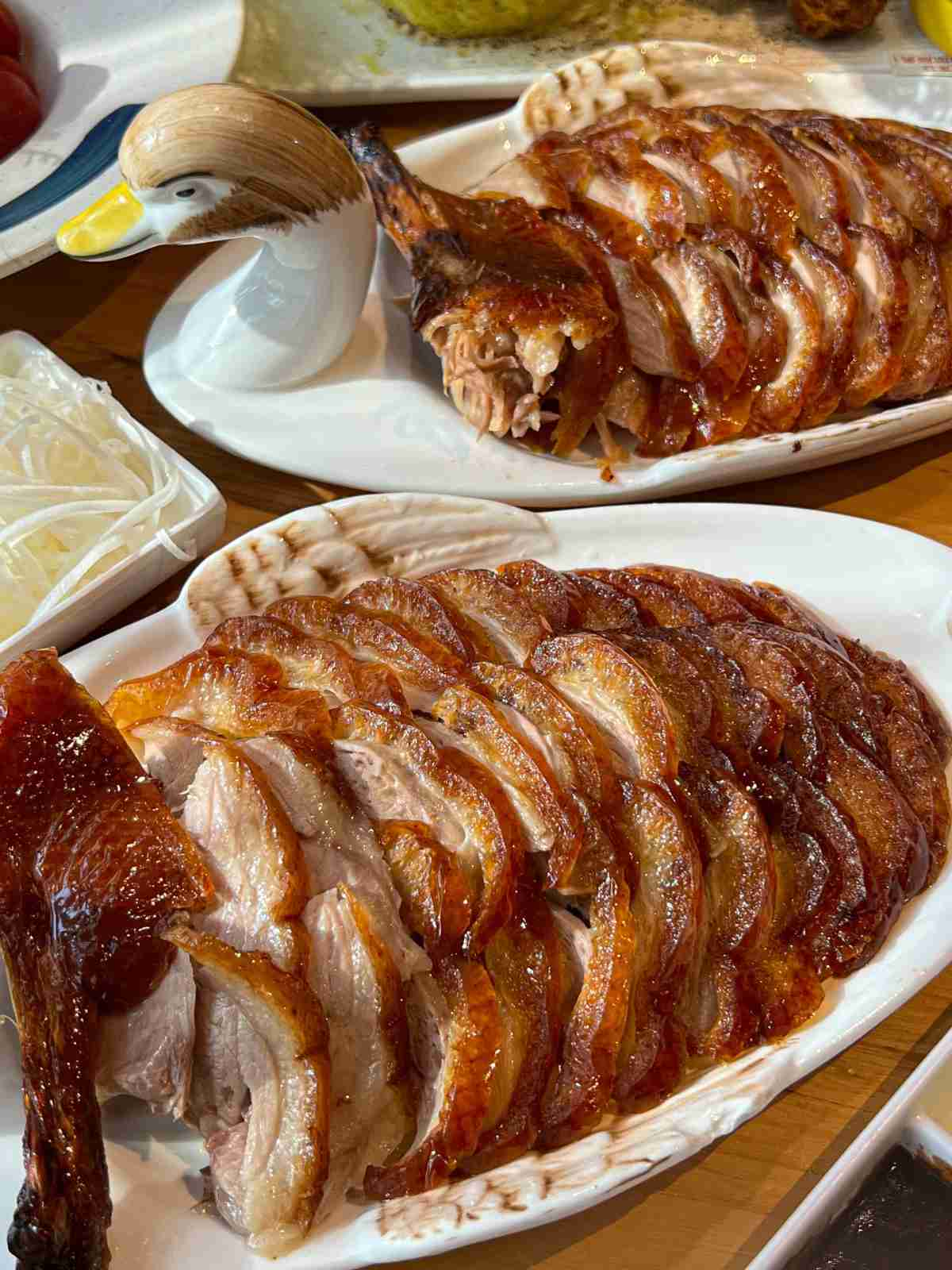
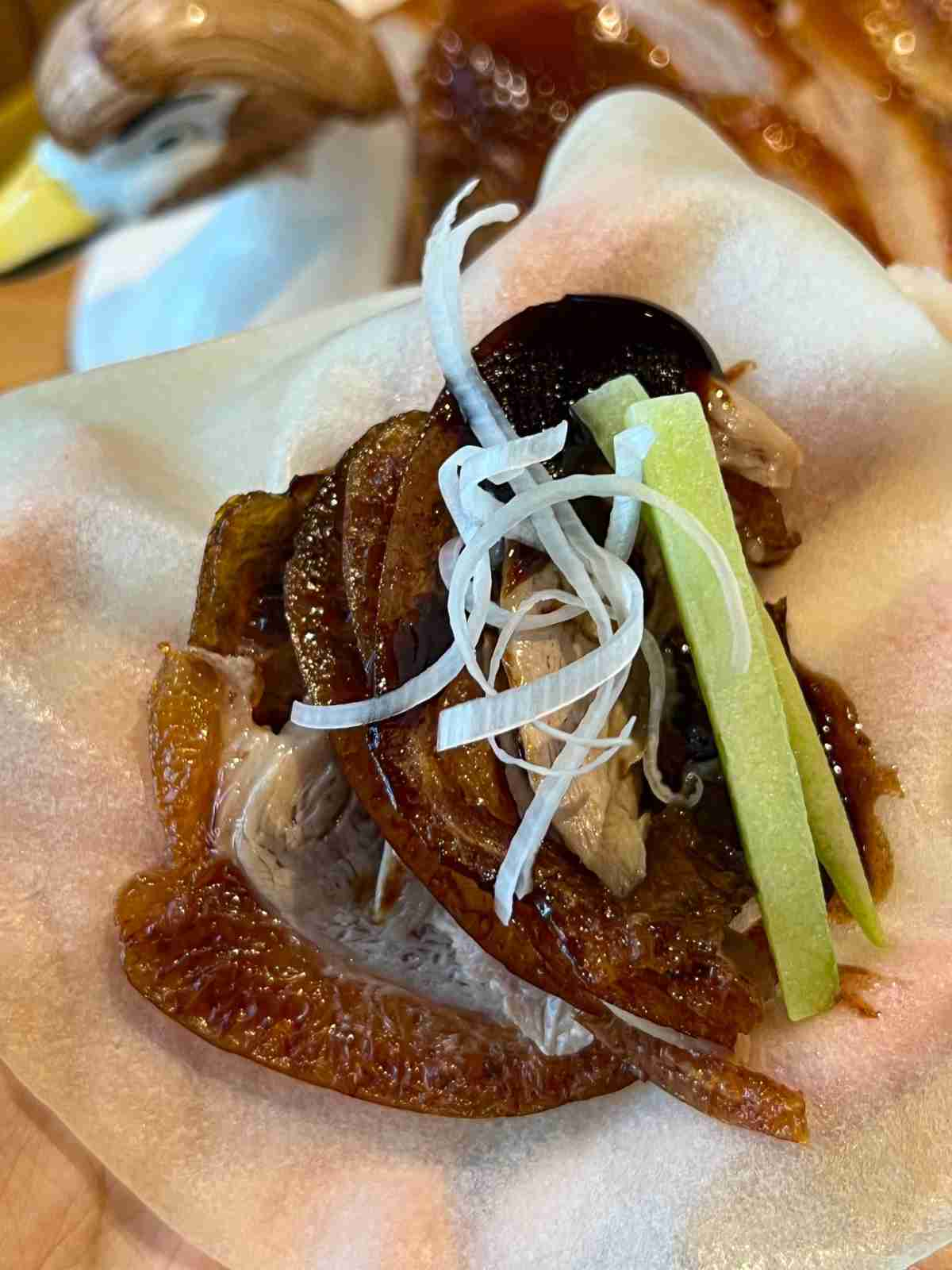
You absolutely must try Peking Roast Duck when visiting Beijing. This famous Chinese dish originating from the Ming dynasty's imperial palace has a history spanning centuries.
Known for its thin crispy skin and tender meat, it's typically sliced into thin pieces, wrapped in a pancake with sauces and scallions, and eaten whole in one bite.
Bite down and all the flavors instantly explode in your mouth – you can even hear the crunchy duck skin crackle. Wow, it's so delicious!
Where to Try the Best Peking Duck in Beijing?
- Qianmen Quanjude: The most famous Peking duck restaurant in Beijing, a true century-old establishment.
- Da Dong: Uses young ducklings, less oily with a roasted aroma, delivering the ultimate crispy skin taste.
- Siji Minfu Roast Duck (Gugong): The most tender meat quality at an affordable price. Next to the Forbidden City, you can see the Forbidden City right out the window.
Best Peking Duck Tours in Beijing
2.Dumplings – 饺子

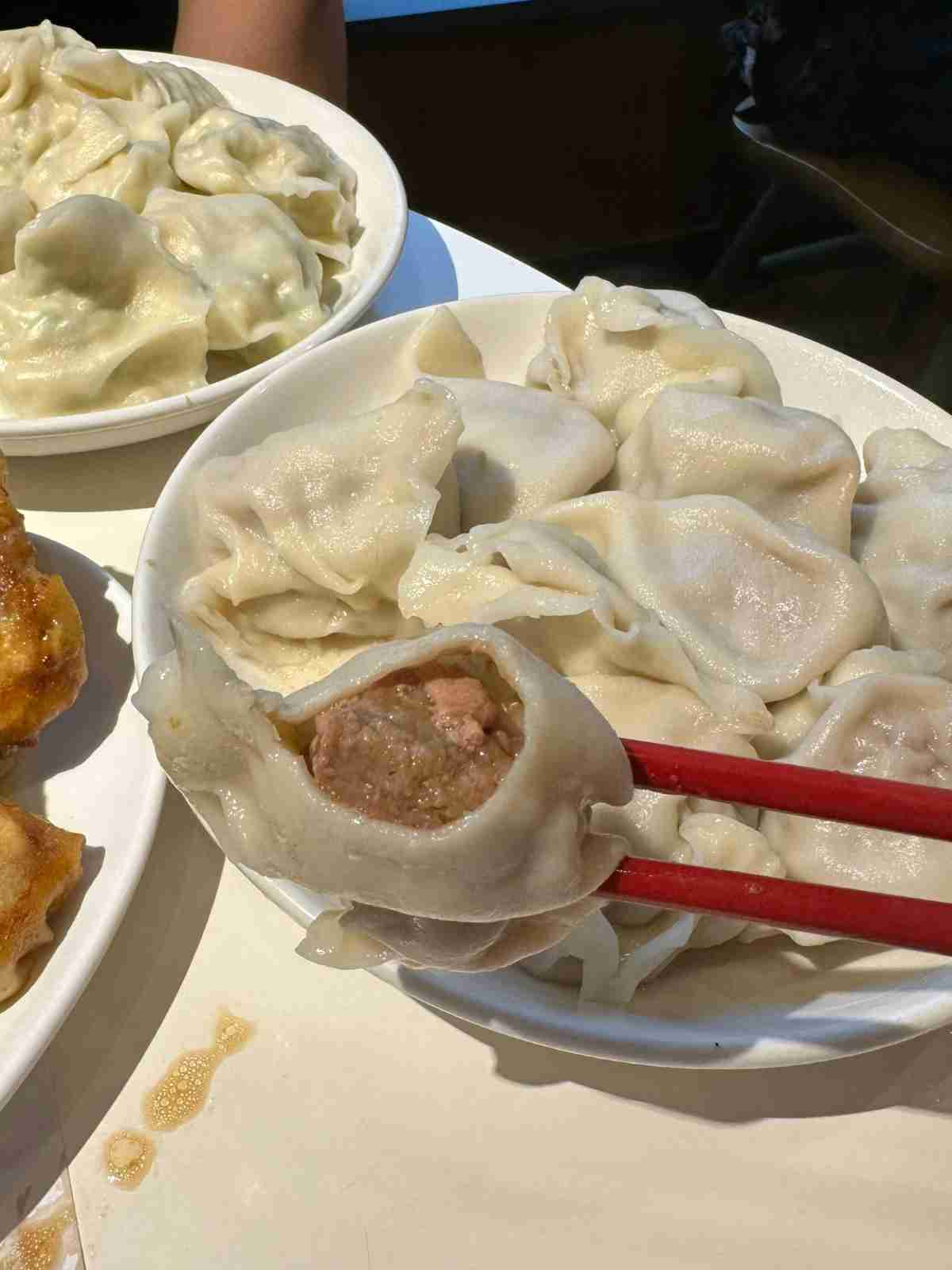
Dumplings, also known as Jiaozi, are a traditional Chinese dish that is popular in Beijing and throughout China. They are made with a thin dough wrapper that is filled with a variety of meats and vegetables, such as pork, cabbage, and chives.
The dumplings are then boiled, steamed, or fried. Beijing dumplings are typically served with a dipping sauce made from vinegar, soy sauce, and chili oil. They are often eaten as a snack or appetizer, but they can also be served as a main course.
In northern China, making dumplings is an important family activity during Chinese New Year, with all family members gathering on New Year's Eve to make and eat dumplings together, representing reunion and happiness.
Dumplings also symbolize wealth and prosperity as their shape resembles ancient Chinese ingots.
Now ,Dumplings are a staple in Beijing, found on menus at hole-in-the-wall hutong eateries and fancy restaurants alike.
Here are the best dumpling restaurants in Beijing for authentic local flavor.
Where to Try the Best Dumplings in Beijing?
- Mr. Shi's Dumplings: Aside from traditional Chinese flavors like chive, shrimp, celery dumplings, there are also amazing Western-style ones like curry pork, cheese beef, cheese chicken that you absolutely must try.
- Xian Lao Man: Boasts the greatest variety of fillings, with big fillings and thin wrappers, the dumpling broth is incredible.
- Baoyuan: Michelin-recommended restaurant, unlike the plain white dumplings elsewhere, theirs come in a variety of fun colors – beautiful and delicious.
Best Dumplings Tours in Beijing
3.Mongolian Hot Pot- 铜锅涮肉

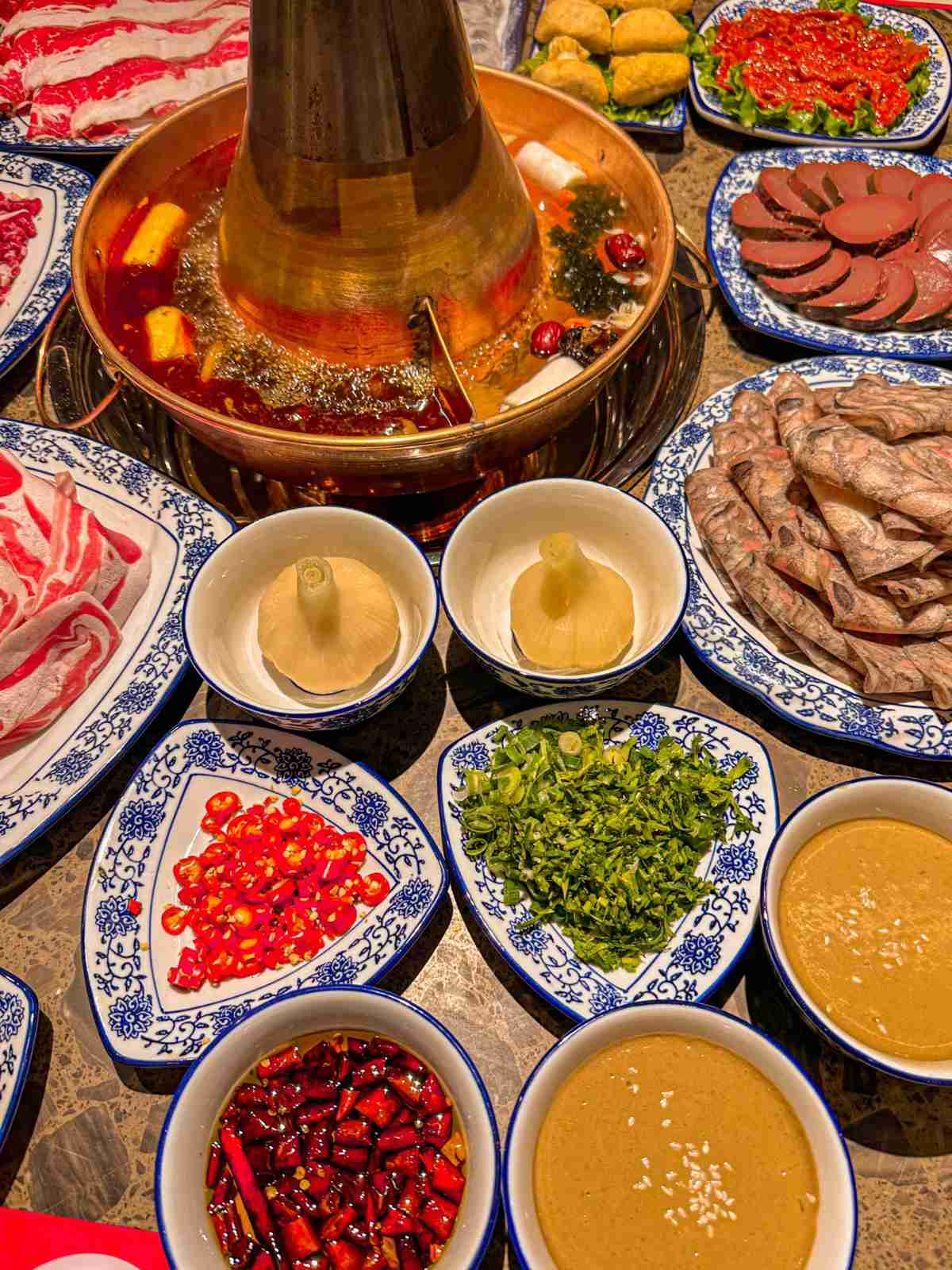
Mongolian hotpot did not actually originate from Mongolia. It is a traditional Beijing dish named after the shape of the pot resembling a Mongolian tent. However, it is not as spicy as Sichuan hotpot.
The basic concept of Mongolian hotpot is simple: a pot of boiling broth is placed in the middle of the table for everyone to cook their own combination of meats, seafood and vegetables directly in the bubbling soup.
The broth is usually made from various seasonings and ingredients like beef, chicken or fish stock, soy sauce, rice vinegar and chili.
To eat Mongolian hotpot, you simply pick the ingredients you want from a buffet spread, then cook them in the broth until done to your liking.
Once your ingredients are cooked to your taste, use a strainer to take them out and enjoy with a variety of dipping sauces.
Pro Tips: To achieve the best texture for mutton, simply rinse it seven times in the boiling hot broth.
Where to Try the Best Mongolian Hot Pot in Beijing?
- Donglaishun: Authentic traditional charcoal hotpot, long-standing brand.
- Ju BaoYuan: Authentic Muslim hotpot, offers herbal soup bases for a unique flavor.
- Xi Yuan Ju Hot Pot: Michelin-recommended restaurant, known for tender lamb.
Best Mongolian Hot Pot Tours in Beijing
4.Beijing Donkey Roll- 驴打滚
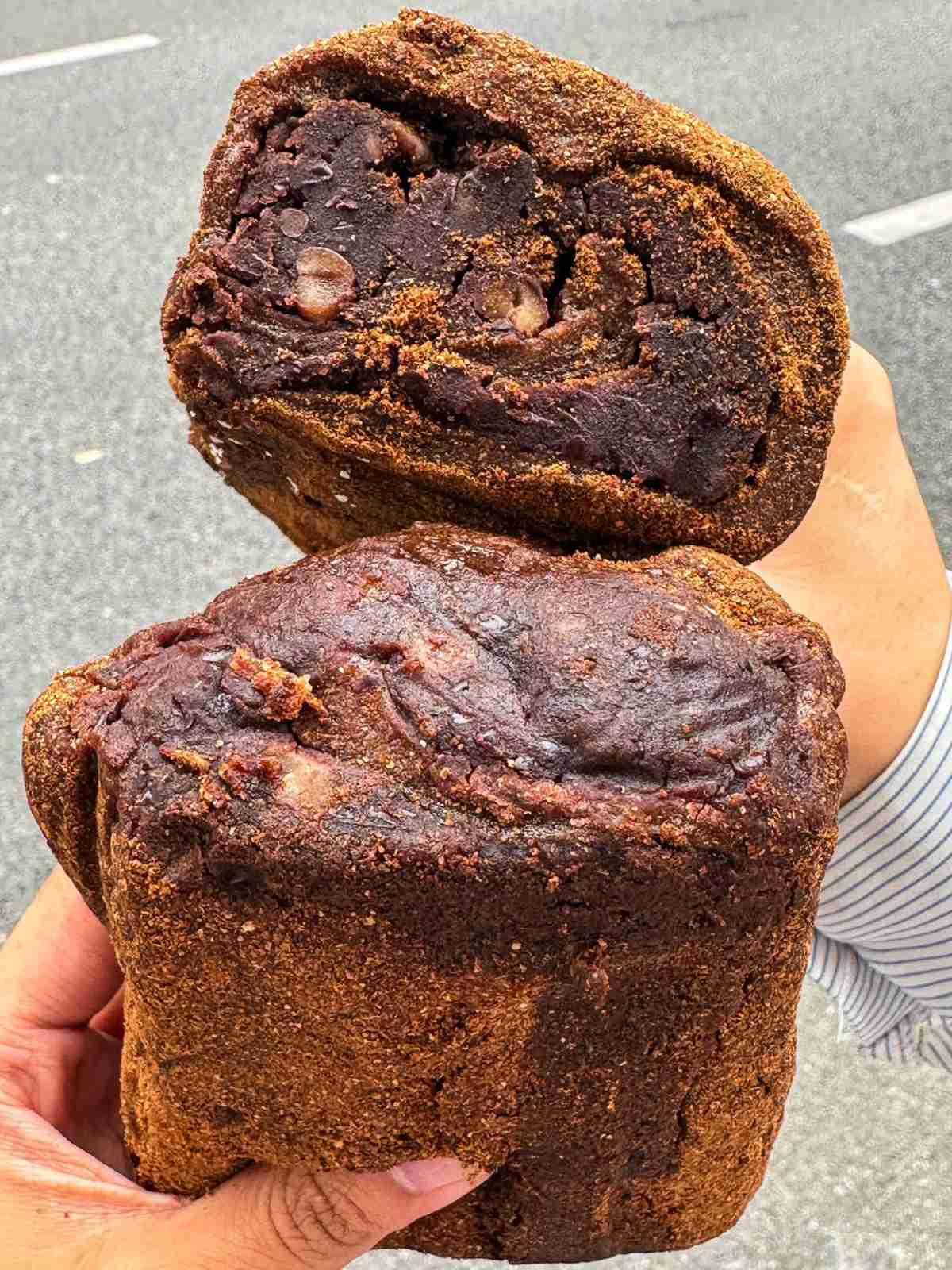
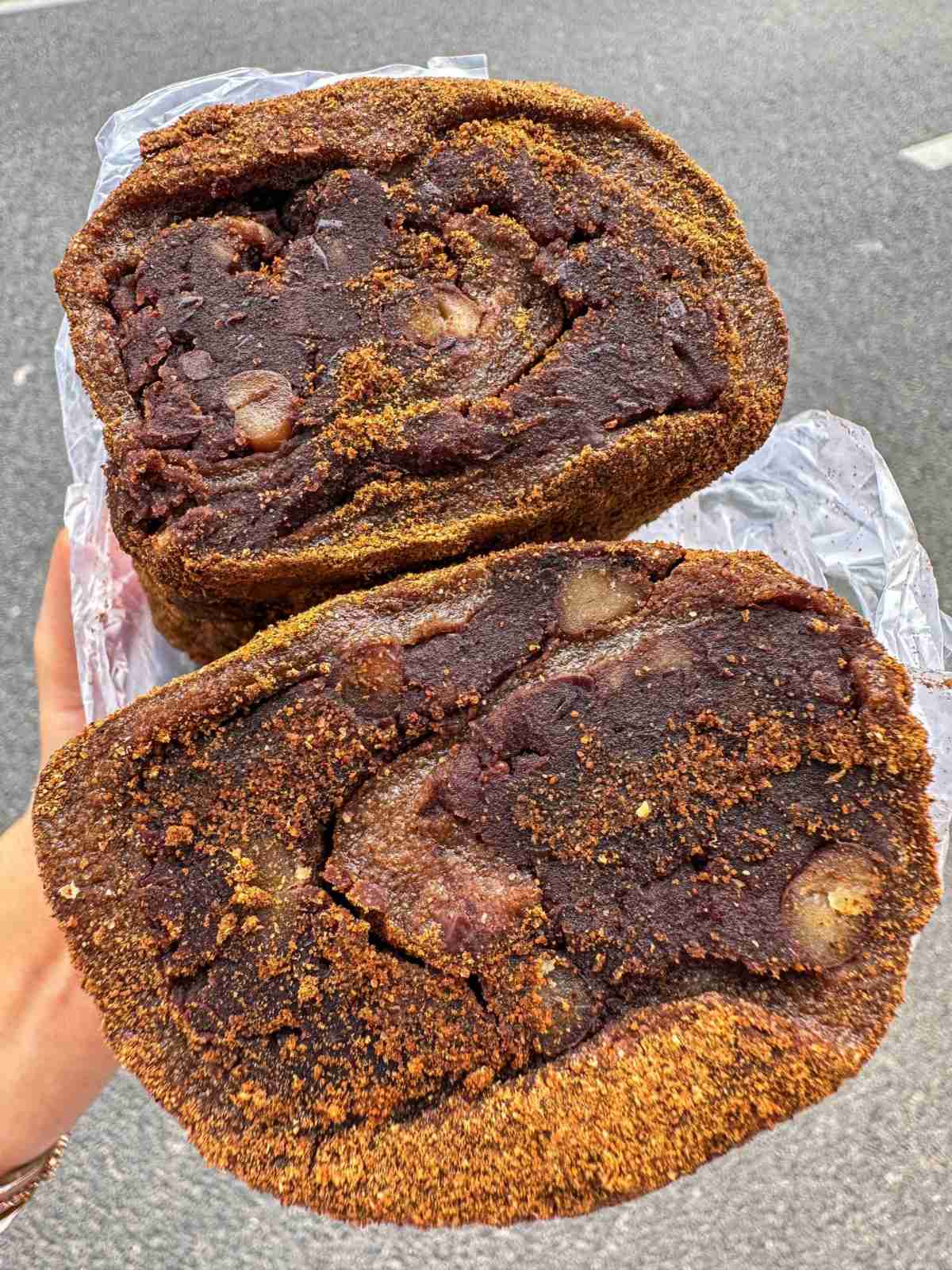
It looks like preserved meat, but it is actually a sweet dessert.
Beijing donkey roll, also known as Lü Dagun (驴打滚), is a popular snack in Beijing and other parts of China. It is made with glutinous rice that is rolled with red bean paste and then rolled in soybean flour.
The dish is known for its sweet and sticky texture and its unique appearance, which resembles a donkey rolling in the dust.
To make Beijing donkey roll, the glutinous rice is first steamed until cooked through. It is then spread out on a flat surface and rolled into a thin sheet.
The red bean paste is spread on top of the glutinous rice and then rolled up tightly. The roll is then cut into pieces and rolled in soybean flour.
Beijing donkey roll is typically served as a snack or dessert. It is often accompanied with tea or other beverages. The dish is also sometimes served as part of a larger meal, such as a dim sum feast.
Where to Try the Best Donkey Roll in Beijing?
- Qianmen Snack Street: A famous street for snacks that is also a tourist attraction, where you can taste donkey rolls and various delicious street food.
- The Hutongs: Beijing has many hutongs, and these places hide all kinds of authentic delicacies.
Best Donkey Roll Tours in Beijing
5.Jian Bing- 煎饼果子
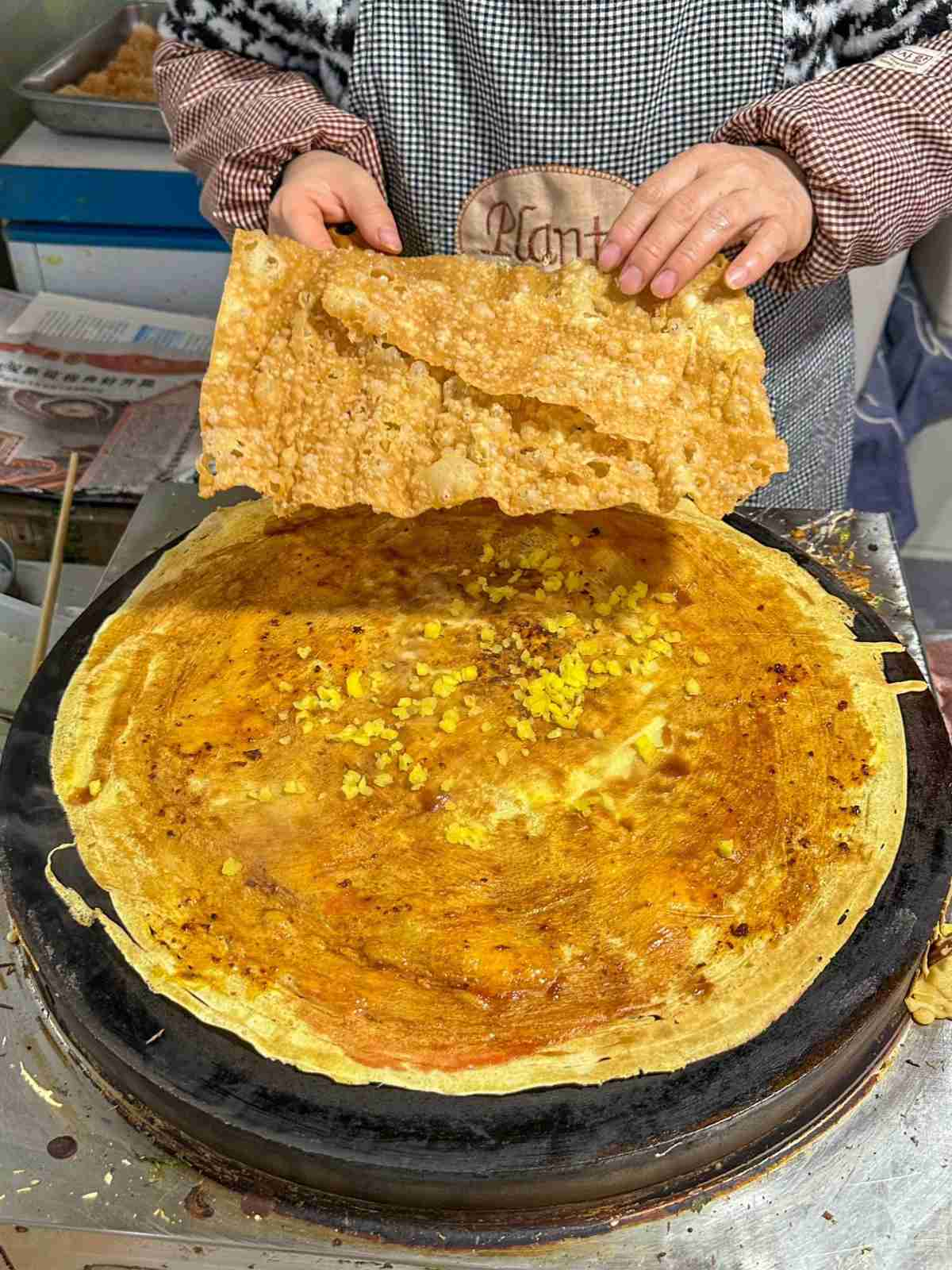
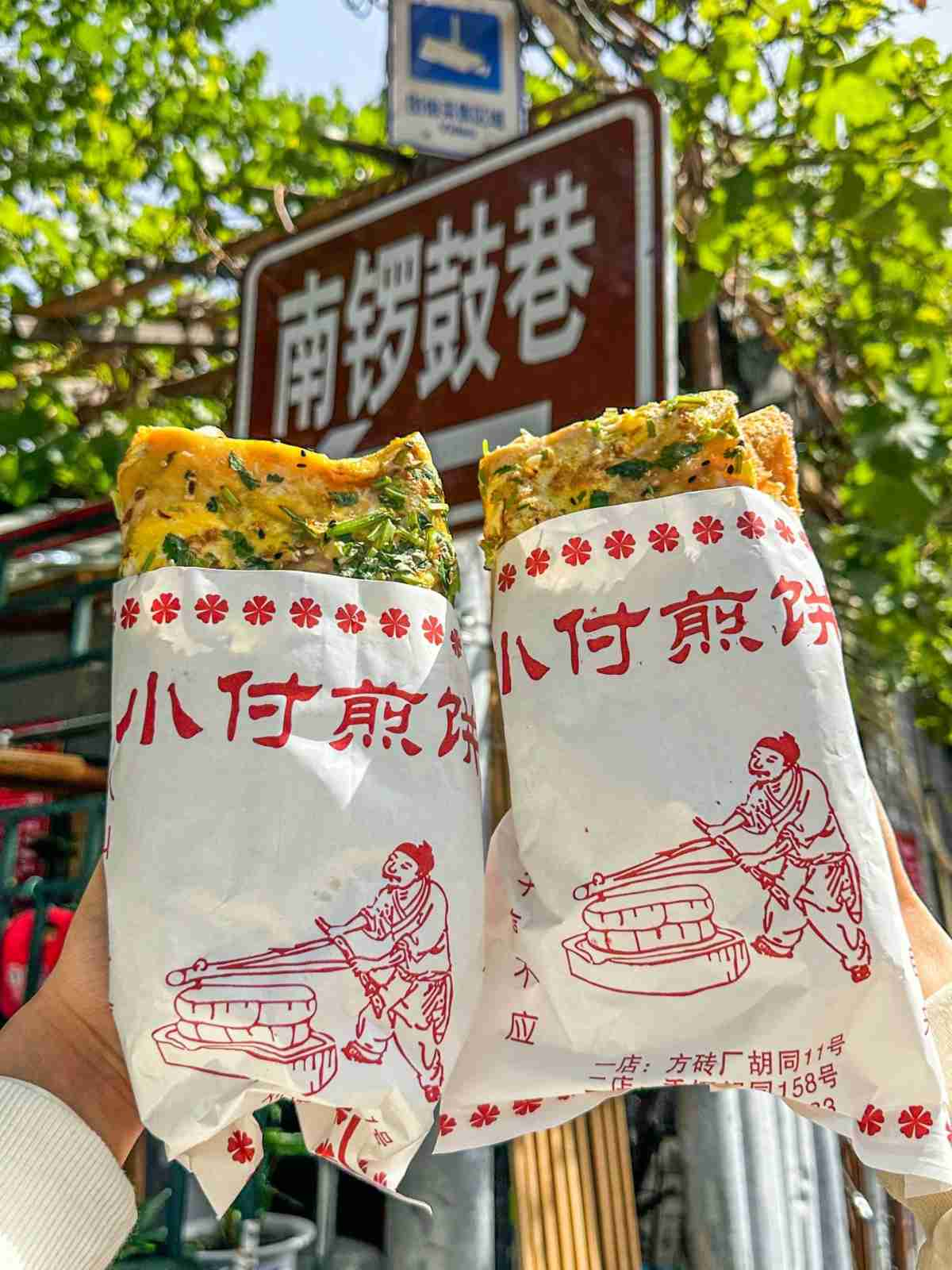
Jianbing is a traditional Chinese savory crepe that is a popular street food, especially for breakfast. It likely originated in China's Shandong province but is now loved all over China.
To make jianbing, a very thin batter made from mung bean flour, water, and spices is spread onto a large circular griddle. An egg is cracked directly on top and spread out to cook.
Various fillings are added, such as fried crackers, spring onions, vegetables, meat floss, or sauces. The crepe is folded over into a half-moon shape to enclose the fillings.
A classic jianbing is filled with crispy wonton crackers, fried egg, sweet bean sauce, cilantro and green onions. However, fillings can vary greatly by region and taste.
Where to Try the Best Jianbing in Beijing?
- Nanluoguxiang: In the hutong alleys here is a small pancake shop named XiaoFuJiangBing that attracts many people to come and taste its famous pancakes.
- The Hutongs: Beijing has many hutongs, and these places hide all kinds of authentic delicacies.
Best Jianbing Tours in Beijing
6.Beijing Luzhu- 卤煮
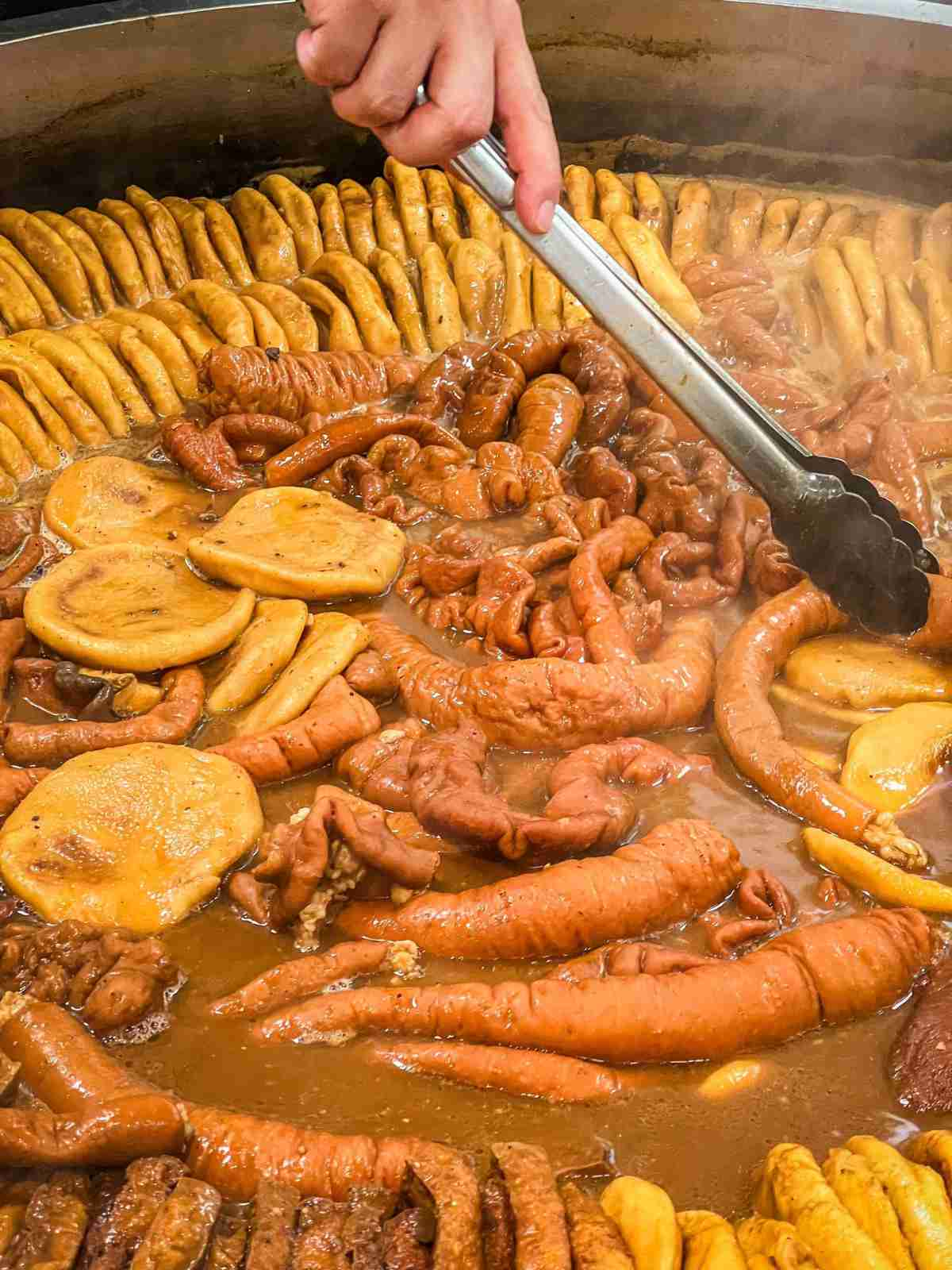

Luzhu refers to a style of braised, stewed dishes that are quintessential to Beijing cuisine. The name literally means “braised food” in Chinese.
Luzhu dishes typically involve meat, offal or vegetables stewed for a long time in a complex braising liquid until very tender.
The braising liquid often includes soy sauce, rice wine, spices, and rock sugar, creating a rich umami-sweet flavor. Common lu dishes include:
- Lu daokou – braised pork belly
- Lu yurou – braised fish in a savory brown sauce
- Lu doufu – braised soft tofu cubes
- Lu ya – braised duck
- Lu baicai – braised Chinese cabbage
What makes luzhu special is the care and technique involved. The meat is carefully prepared, then simmered for hours in the master stock, enriching the flavors.
The results are melt-in-your-mouth tender meat and vegetables in a thick, aromatic gravy.
For people who do not eat organ meats, this snack may be a challenge.
Where to Try the Best Luzhu in Beijing?
- Chen Shi LuZhu XiaoChang: The flavor is authentic, the organ meats are handled very cleanly.
- HuangSi LuZhu: The braised pork elbows at this restaurant are extremely delicious, they melt in your mouth, fatty but not greasy.
Best LuZhu Tours in Beijing
7.Donkey Burger- 驴肉火烧
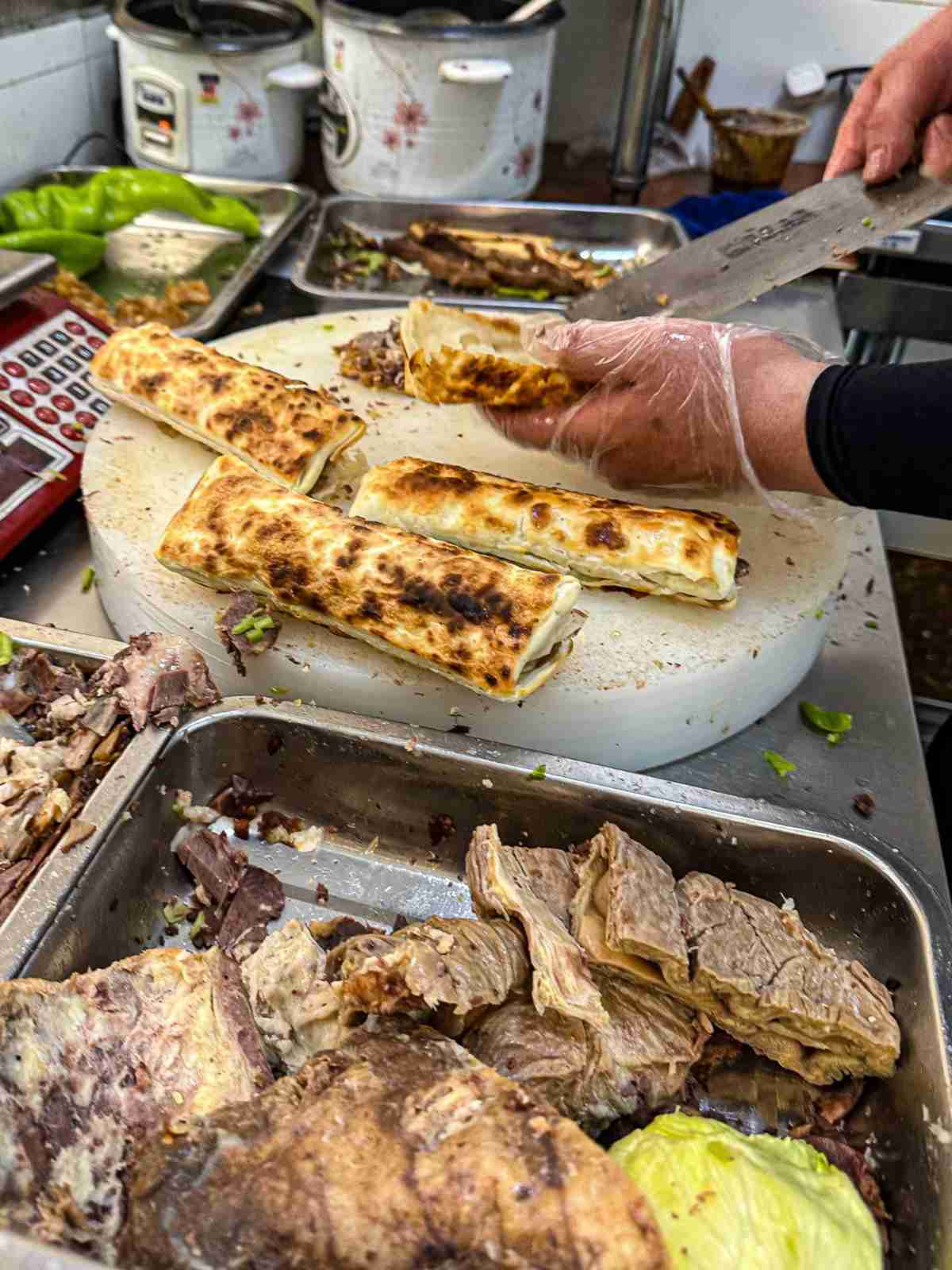
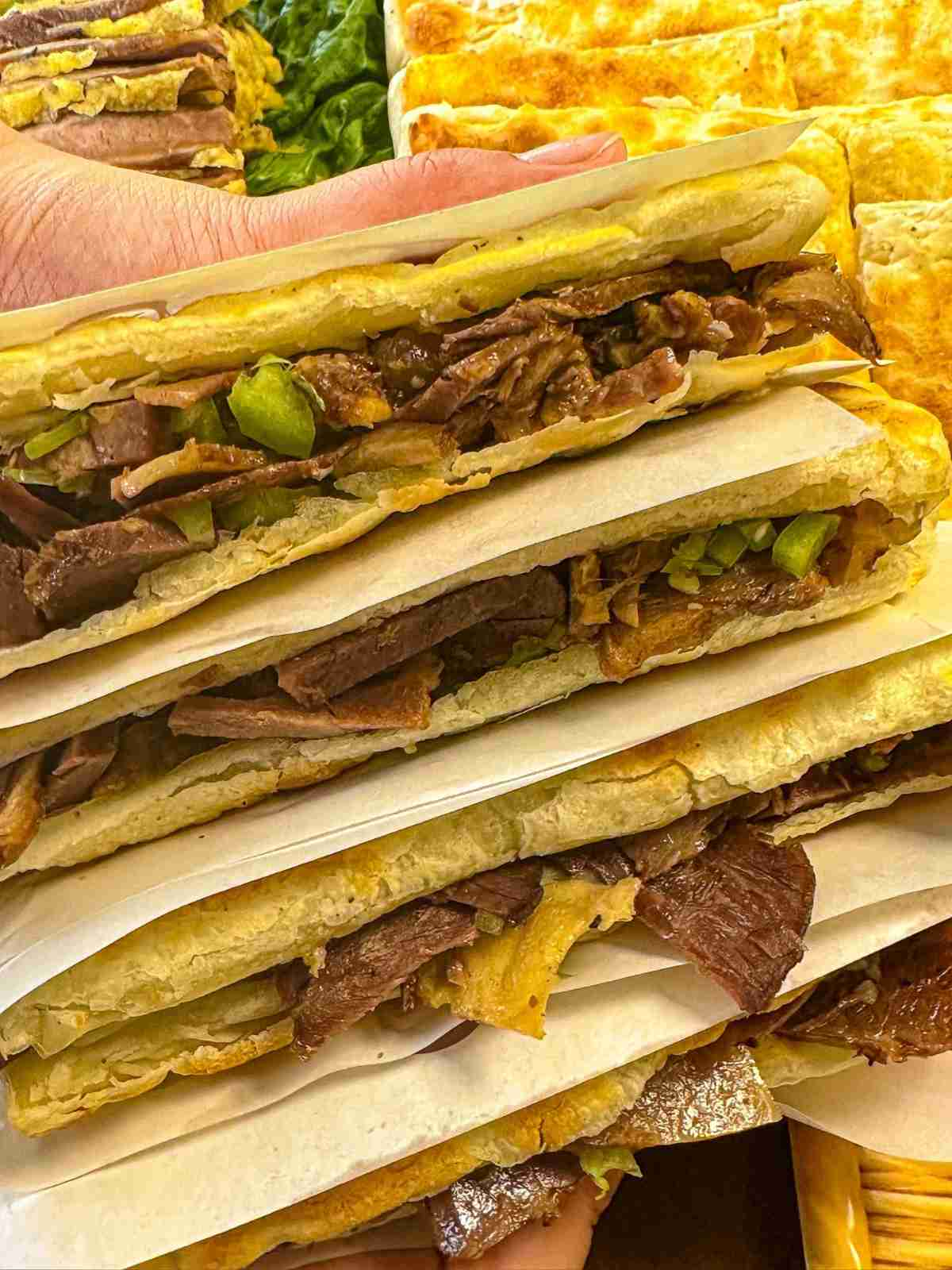
Yes, this is real donkey meat.
There is a saying that goes “dragon meat in the sky, donkey meat on the ground”, which is used to describe how delicious donkey meat is.
Donkey meat has been eaten in China for thousands of years and is especially popular in northern regions like Beijing. The meat is leaner than pork or beef but still flavorful.
For Donkey Pancake, it is cut into bite-sized pieces, then marinated in a mixture of cumin, chili powder, garlic, and other spices.
The seasoned donkey meat cubes are threaded onto thin metal skewers before being cooked over a hot grill or portable burner. The sizzling hot flames impart a smoky char flavor while the spices and marinade further enhance the meat.
Donkey burgers is grilled over high heat until the outside becomes crispy. They should be eaten hot right off the grill.
The combination of aromatic spices, tender donkey meat and charred edges makes it an addictive street food delicacy.
Where to Try the Best Donkey Burger in Beijing?
- Wang Fat Ass Flesh Fire: Delicious donkey burgers paired with the restaurant's signature soup fully satisfy your appetite.
- Old Peng Donkey Meat: Offering classic flavored donkey meat, this restaurant has several branches in Beijing.
Best Donkey Burger Tours in Beijing
8.Chaogan – 炒肝
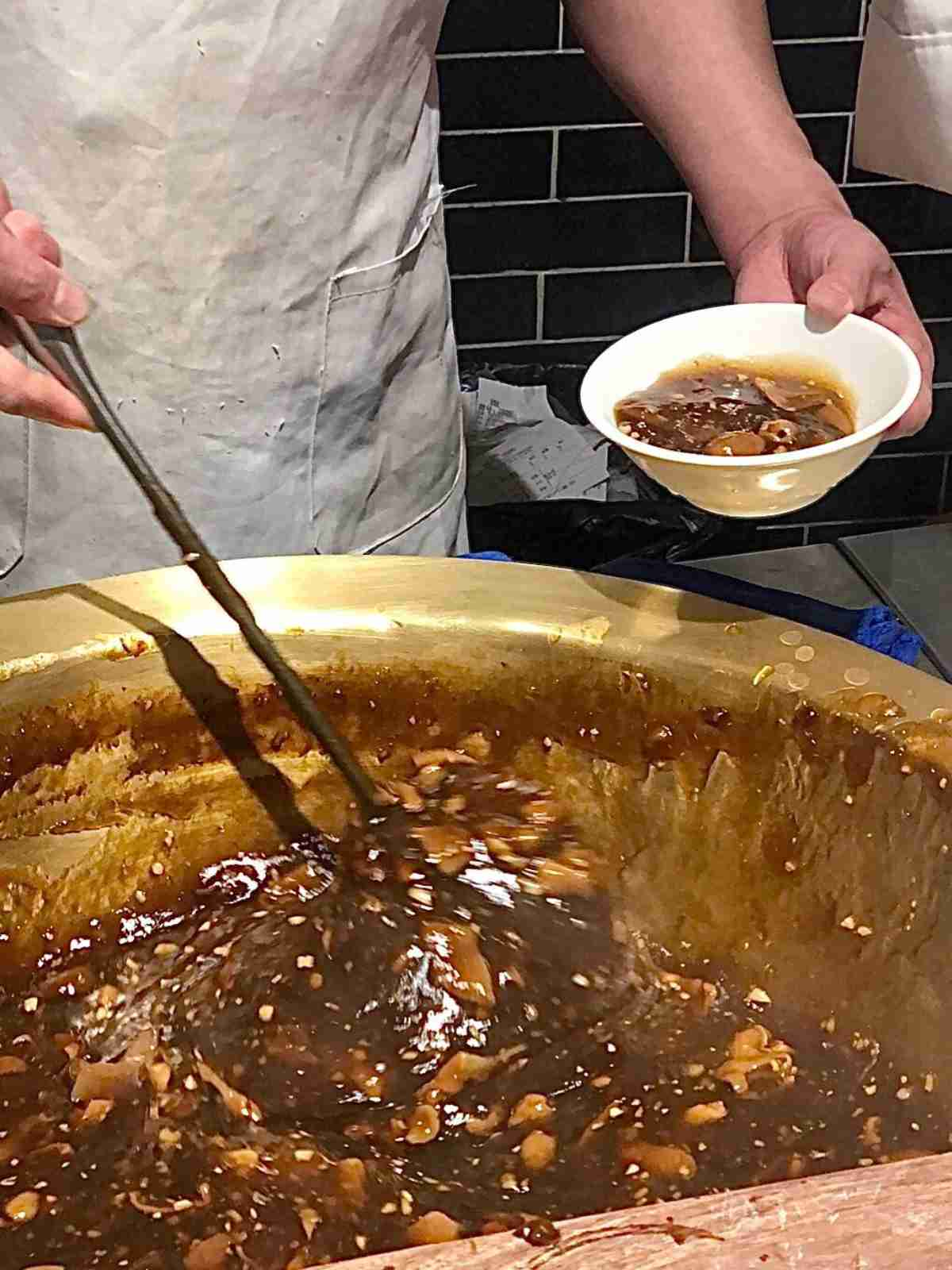
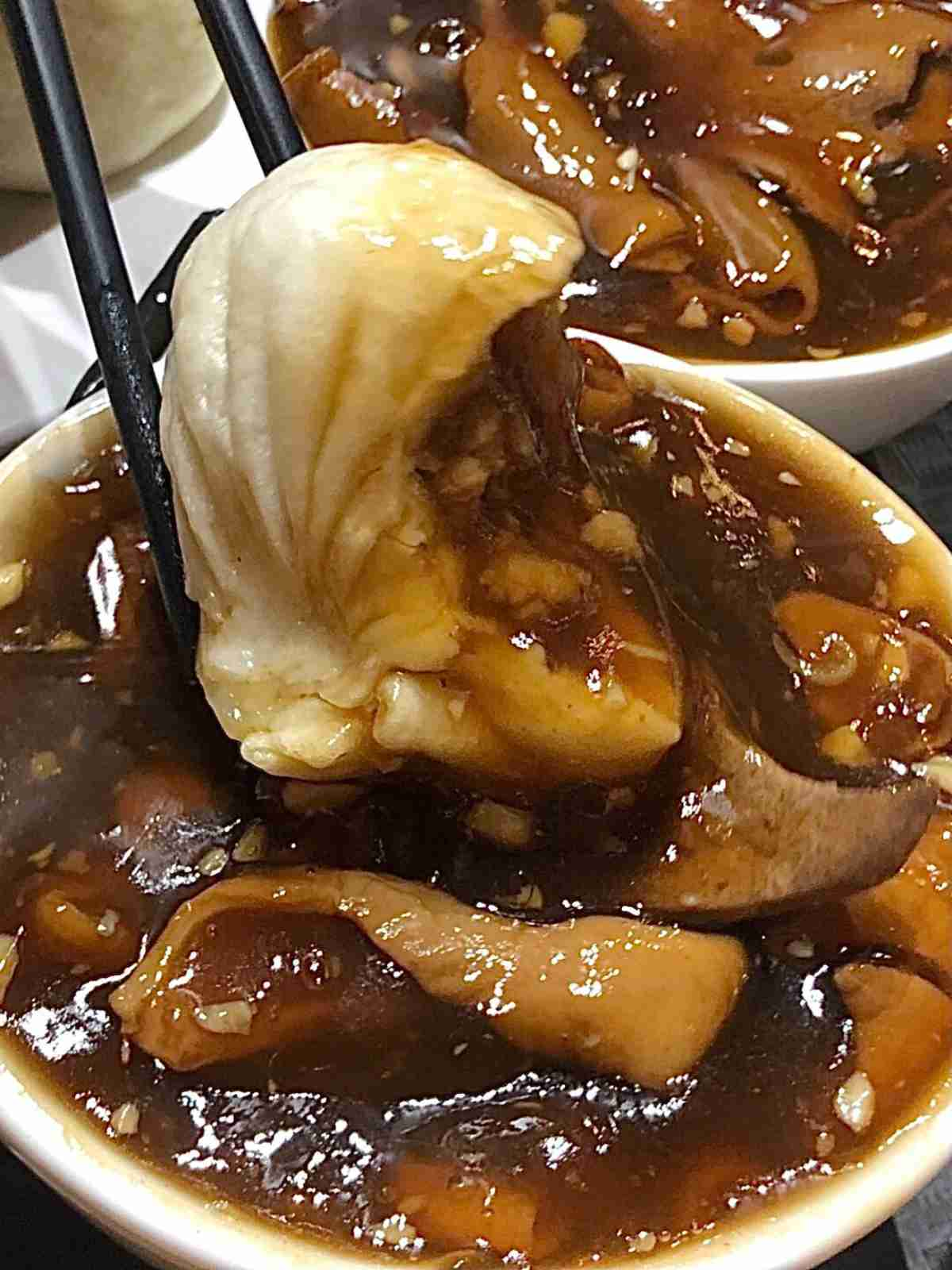
Chaogan, also known as fried liver and tripe, is a popular street food in Beijing. It is made with liver, tripe, and other internal organs that are fried in a sauce made with soy sauce, spices, and herbs. The dish is known for its rich flavor and hearty texture.
To make Beijing chaogan, the liver and tripe are first cleaned and boiled. They are then cut into small pieces and fried in a wok with oil, onions, starch and garlic.
The sauce is made with soy sauce, spices, and herbs, and is added to the wok along with the liver and tripe. The dish is cooked until the liver and tripe are tender and the sauce has thickened.
Chaogan is usually eaten together with buns. Locals dip the buns in the sauce before putting them in their mouths. This is an authentic local way of eating it.
Where to Try the Best Chaogan in Beijing?
- Yaoji Chaogan Restaurant: The best Chaogan restaurant in Beijing, which has hosted Joe Biden before.
- YuanZhaoji: Generous with ingredients and affordable, it is very popular among Beijing locals.
Best Chaogan Tours in Beijing
9.Zhajiang Noodles- 炸酱面
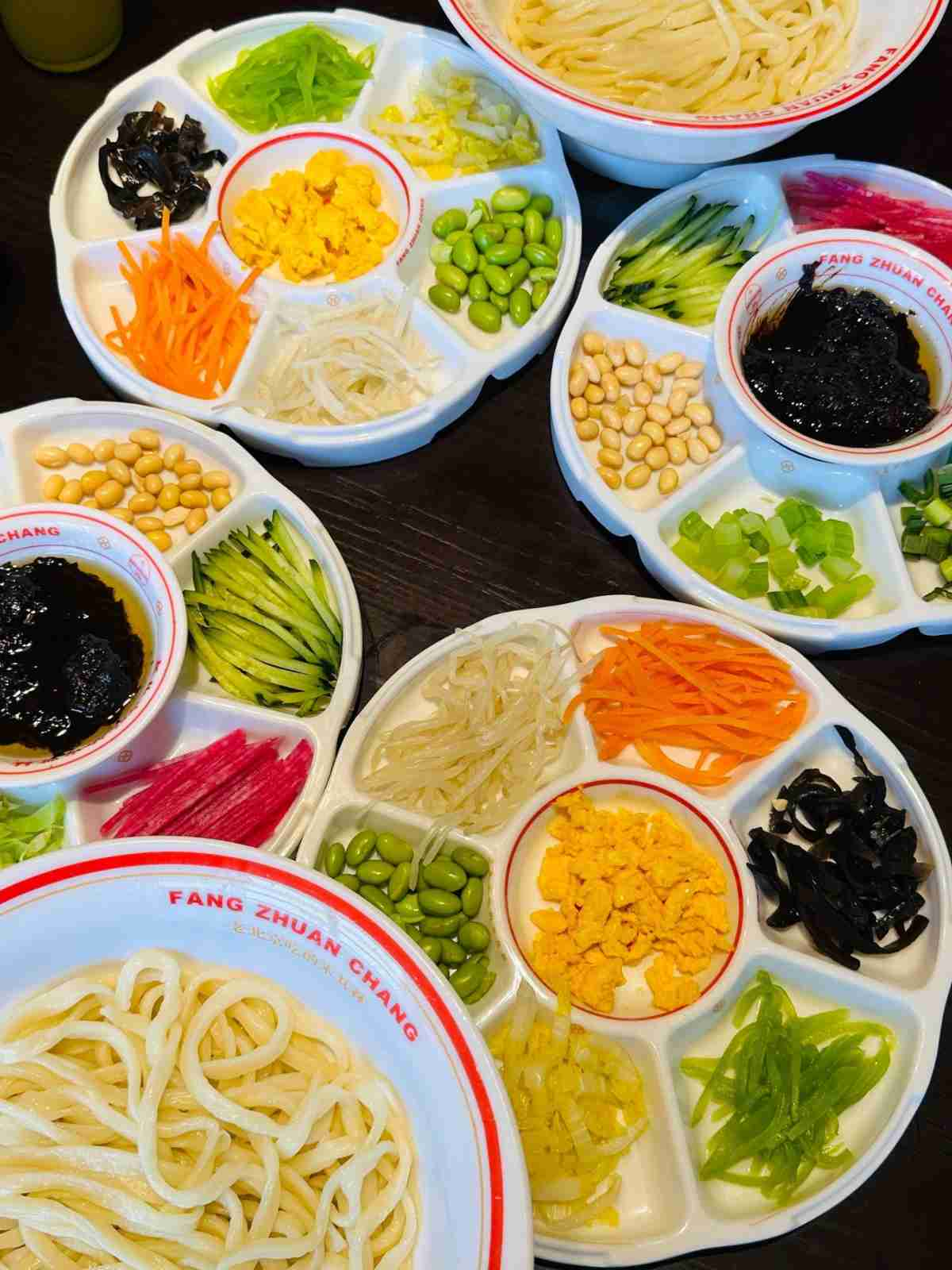
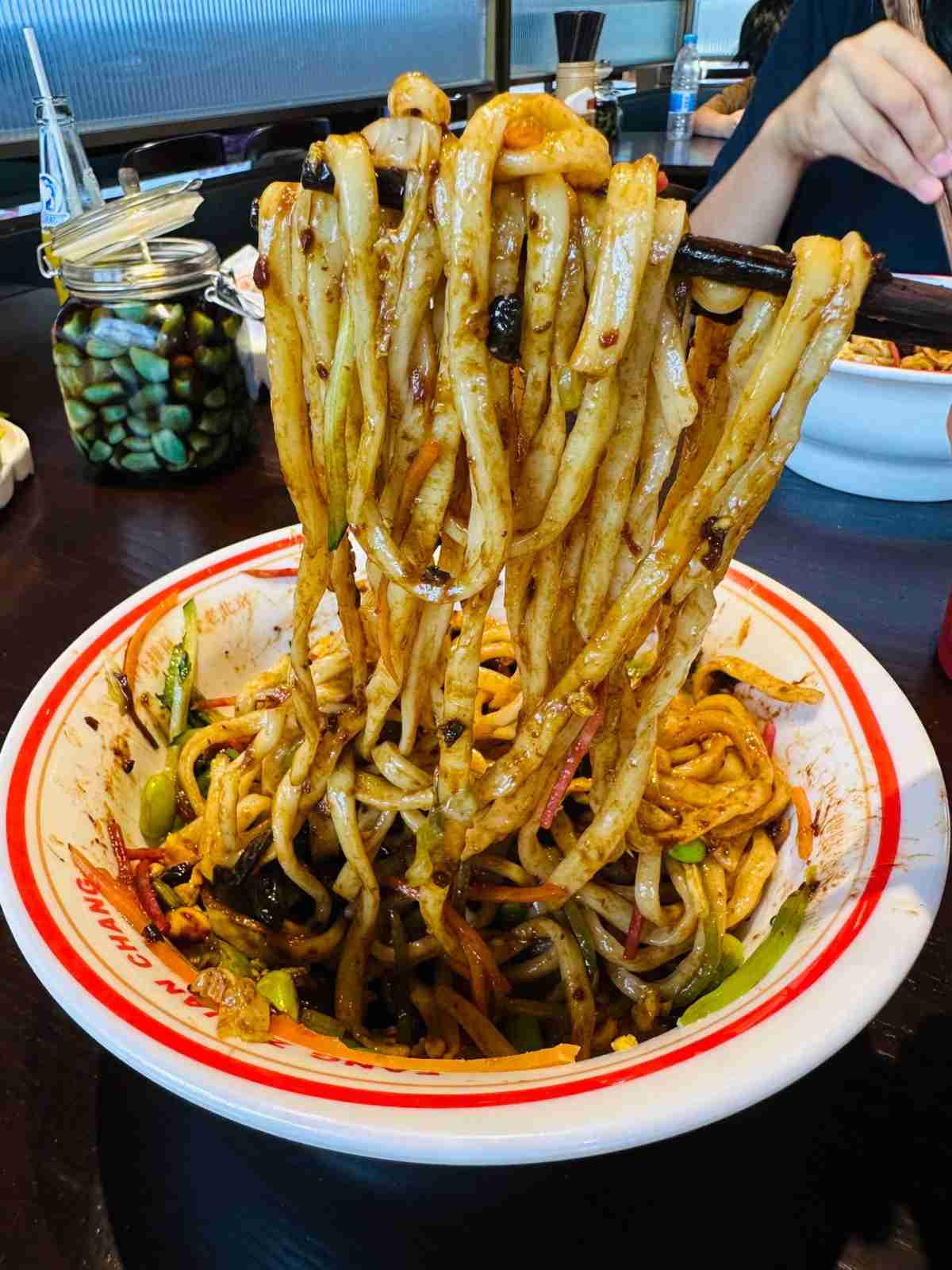
Zhajiang noodles (also known as zhajiang mian) consists of noodles topped with a thick meat sauce. It is considered one of the hallmark dishes of Beijing cuisine.
The main component of the dish is the zhajiang sauce. This is made by stir-frying ground pork or beef with salty fermented soybean paste.
This gives the sauce its signature savory umami flavor. Diced vegetables like carrot, cabbage, and bean sprouts are also commonly added.
The sauce is ladled generously over noodles – typically thick wheat noodles, but thin egg noodles may also be used. When tossed together, the noodles absorb the rich flavors of the meat sauce.
Zhajiang noodles is customizable with different meat fillings and noodle types. Common additions include julienned cucumber, shredded egg crepe, and black vinegar.
Fried peanuts or sprouts add crunch. Believed to have originated in the early 1900s, zhajiang noodles became popular as an affordable and filling lunch for working folks in Beijing.
Its salty-sweet flavor profile and satisfying texture make it a classic noodle dish that is still widely enjoyed today across China.
Simple but full of umami depth, zhajiang noodles is quintessential Beijing street food fare. It's still often sold as a quick lunch by street vendors across the city.
Where to Try the Best Zhajiang noodles in Beijing?
- Zhajiang Noodle King: A time-honored fried sauce noodle restaurant that offers classic ingredient combinations.
- Fangzhuang Factory No. 69 Zhajiang Noodles: A small unassuming restaurant hidden in a hutong that received a Michelin recommendation and attracts endless streams of customers.
Best Zhajiang noodles Tours in Beijing
10.Tanghulu- 糖葫芦
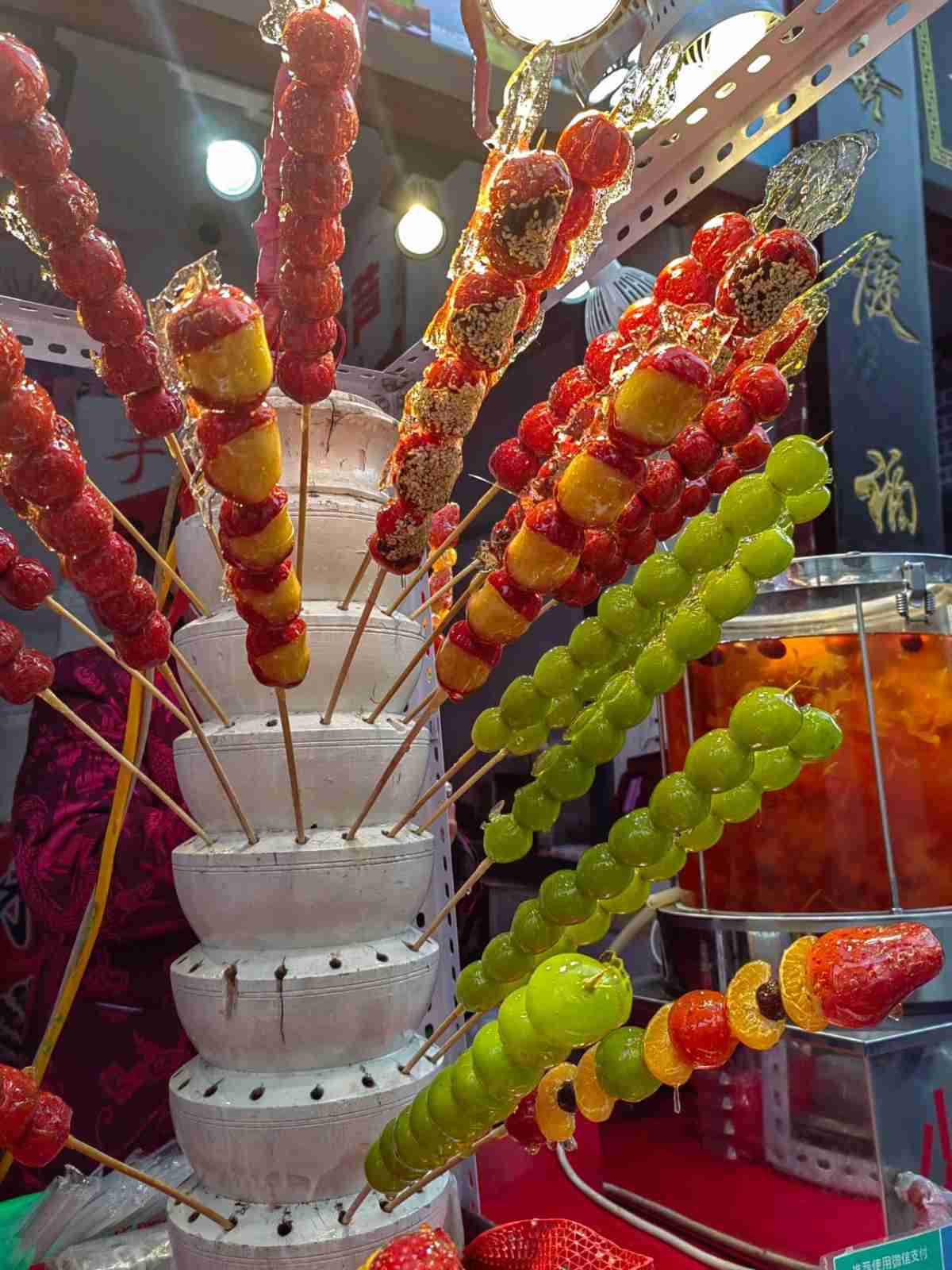

Tanghulu is a sweet-sour candy-coated fruit snack made by coating fresh fruits with hard sugar syrup. It is a specialty snack food of Beijing.
The most common fruits used are small strawberries on skewers, though other fruits like Chinese hawthorns are also popular. The fruits are first rinsed, dried, then dipped into a boiling syrup made from sugar, vinegar and food coloring.
The syrup quickly crystallizes into a hard, brittle shell around the fruit as it cools. The coating is crunchy with a sweet yet slightly sour taste from the vinegar. It perfectly complements the sweet-tart natural flavors of the fruits.
Tanghulu is made and enjoyed throughout China, but it has its origins on the streets of Beijing in the 1800s during the Qing dynasty. Vendors would sell the candied fruits from roadside carts or bicycle baskets, calling out “tanghulu” to attract customers.
Nowadays, this snack has developed all kinds of ingredients and flavors. Aside from fruits, some are also made with certain pastries as the base ingredient. My favorite is the sticky rice flavor!
Where to Try the Best Tanghulu in Beijing?
- Hulude: The most authentic candied haws brand in Beijing.
- Hutong blocks: In the hutongs and alleys of Beijing, you can taste candied haws of all kinds of flavors.
Best Tanghulu Tours in Beijing
11.Beijing Jarred Yogurt – 北京酸奶

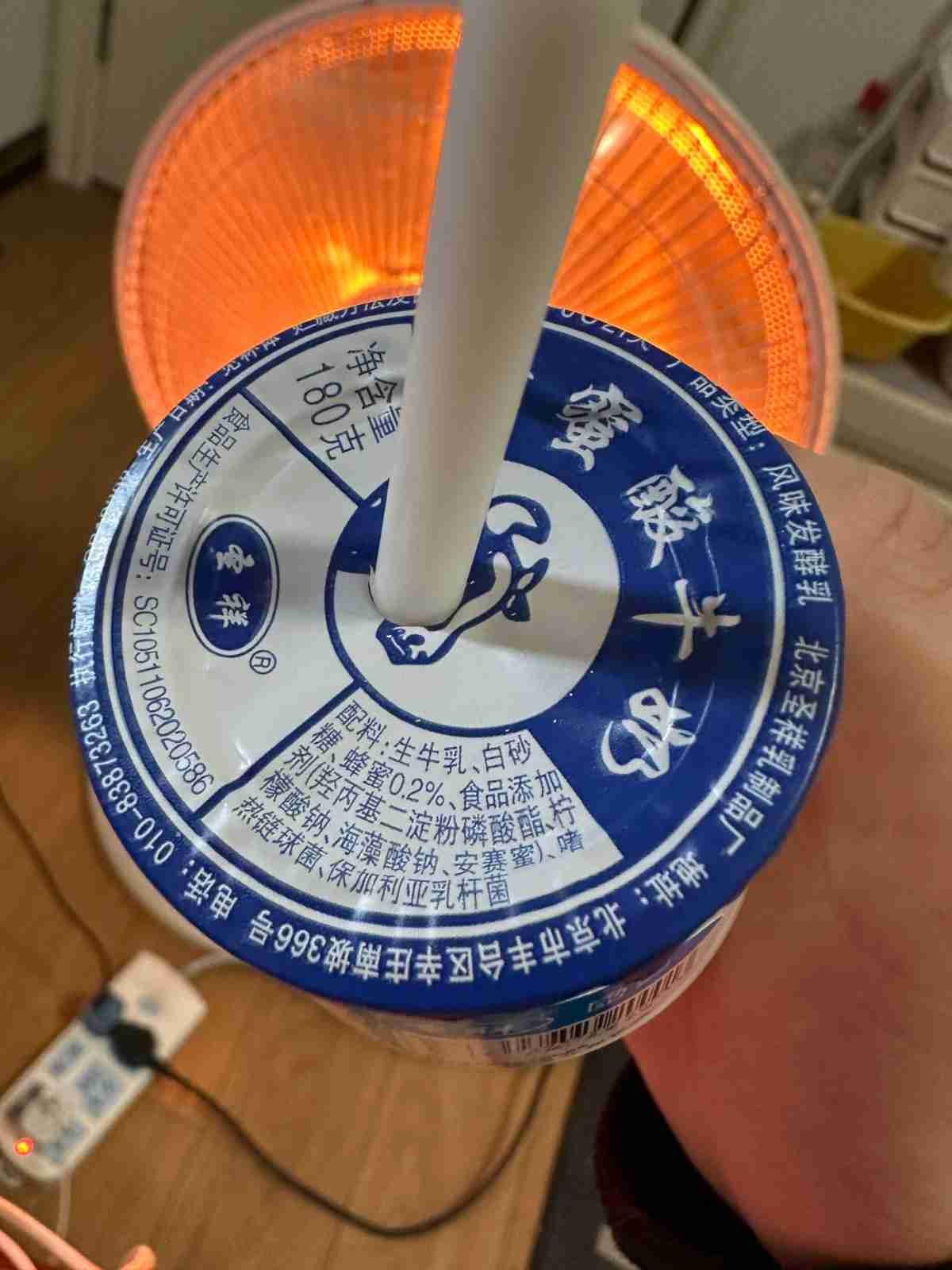
Beijing Jarred Yogurt is a popular fermented dairy product in China. It is made with cow's milk and a unique starter culture that is derived from sweet fermented rice.
Beijing Yogurt is known for its thick, creamy texture and its slightly sweet and tart flavor.
Beijing Yogurt is typically sold in jars and is often eaten as a snack or dessert.
It can also be used in a variety of recipes, such as smoothies, parfaits, and yogurt dips.
Beijing Yogurt is a good source of protein and calcium, and it is also a probiotic food, which means that it contains beneficial bacteria that can help to improve gut health.
Where to Try the Best Beijing Jarred Yogurt in Beijing?
- This product is ubiquitous in Beijing, you can find it in many stores. Look for the ‘Shengxiang' brand, I recommend their honey yogurt flavor.
12.Douzhi And Madoufu – 豆汁和麻豆腐
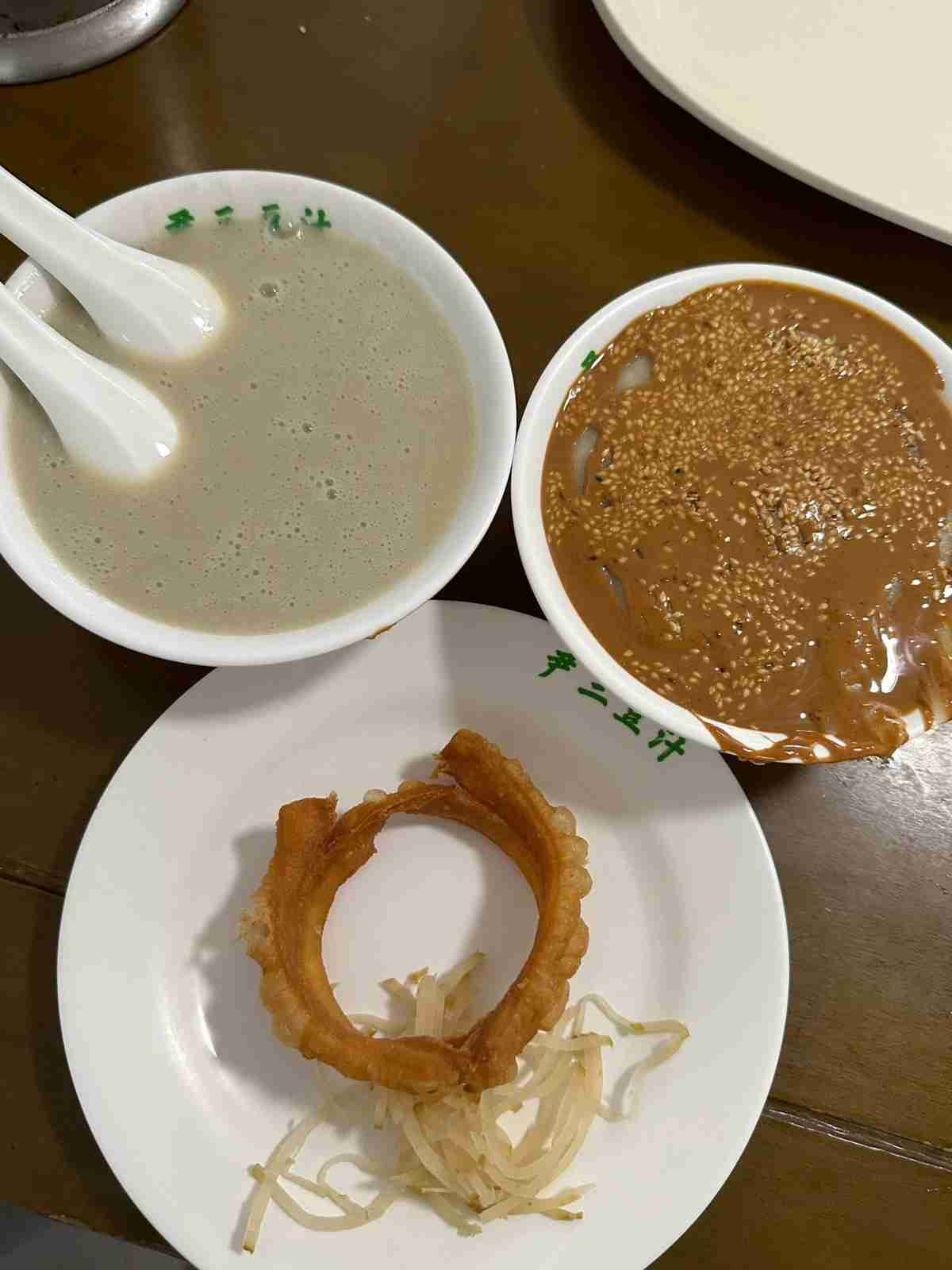
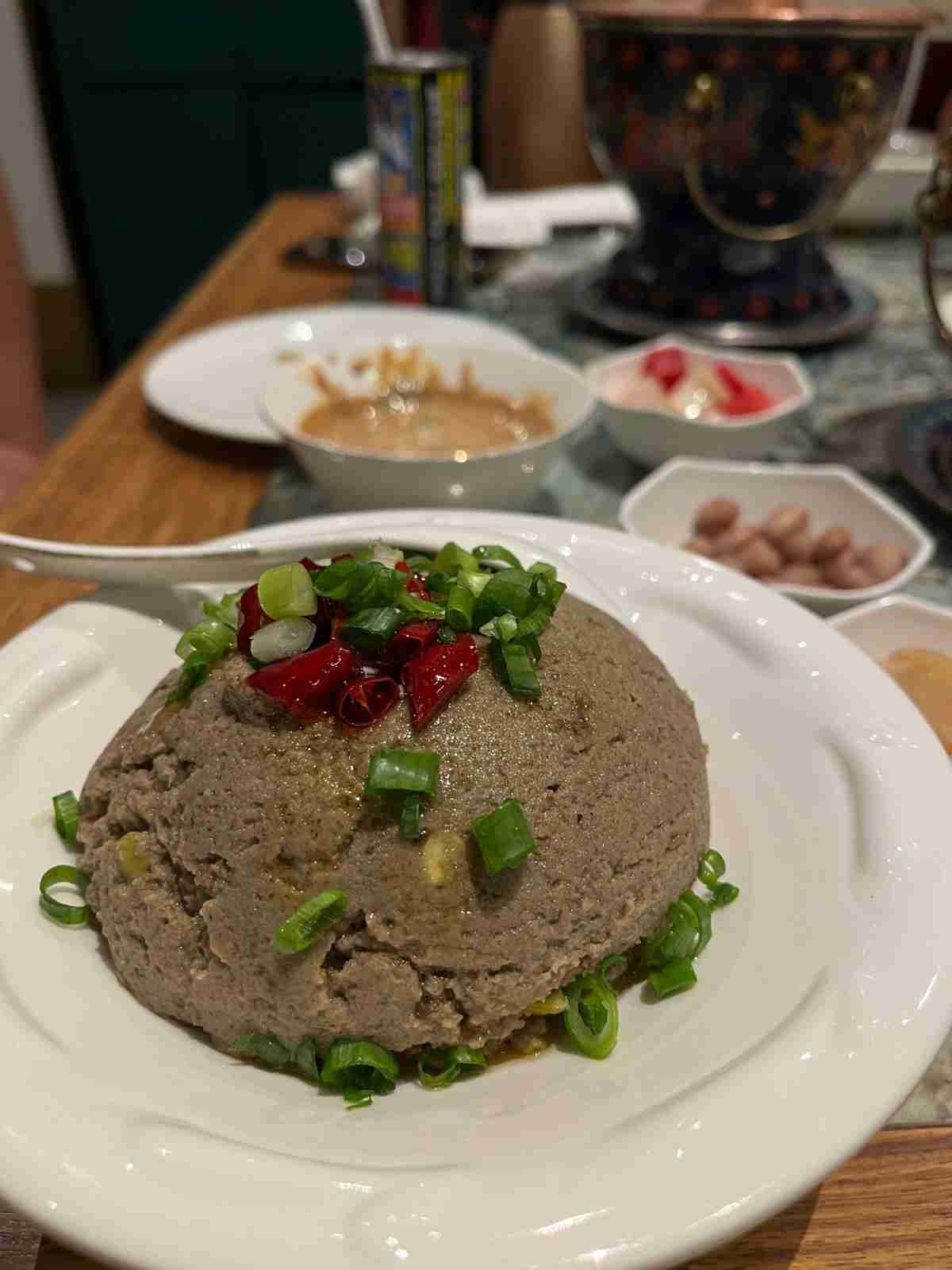
Douzhi and madoufu are two famous traditional snacks in Beijing, China. They are known as the “two wonders of the capital.”
Douzhi is a sour drink made from fermented soybeans, while madoufu is a byproduct of douzhi, which is the solidified soybean dregs after fermentation.
Douzhi has a sour and sweet flavor with a hint of bitterness. It has a thick and creamy texture.
The flavor of madoufu is more concentrated than douzhi, with a stronger sour taste and a finer texture.
Douzhi and madoufu are often eaten together, with douzhi for thirst and madoufu for sustenance.
Pro Tips: These two foods have unique flavors. Some people love them while others frown at them.
Where to Try the Best Douzhi And Madoufu in Beijing?
- Yinsan Douzhi: The pinnacle of douzhi in Beijing, famed for its thick and authentic flavor.
- Ciqikou Old Bean Juice Shop: Near the Temple of Heaven, a good place to have breakfast before sightseeing.
Best Douzhi And Madoufu Tours in Beijing
13.Sugar Pancake – 糖油饼
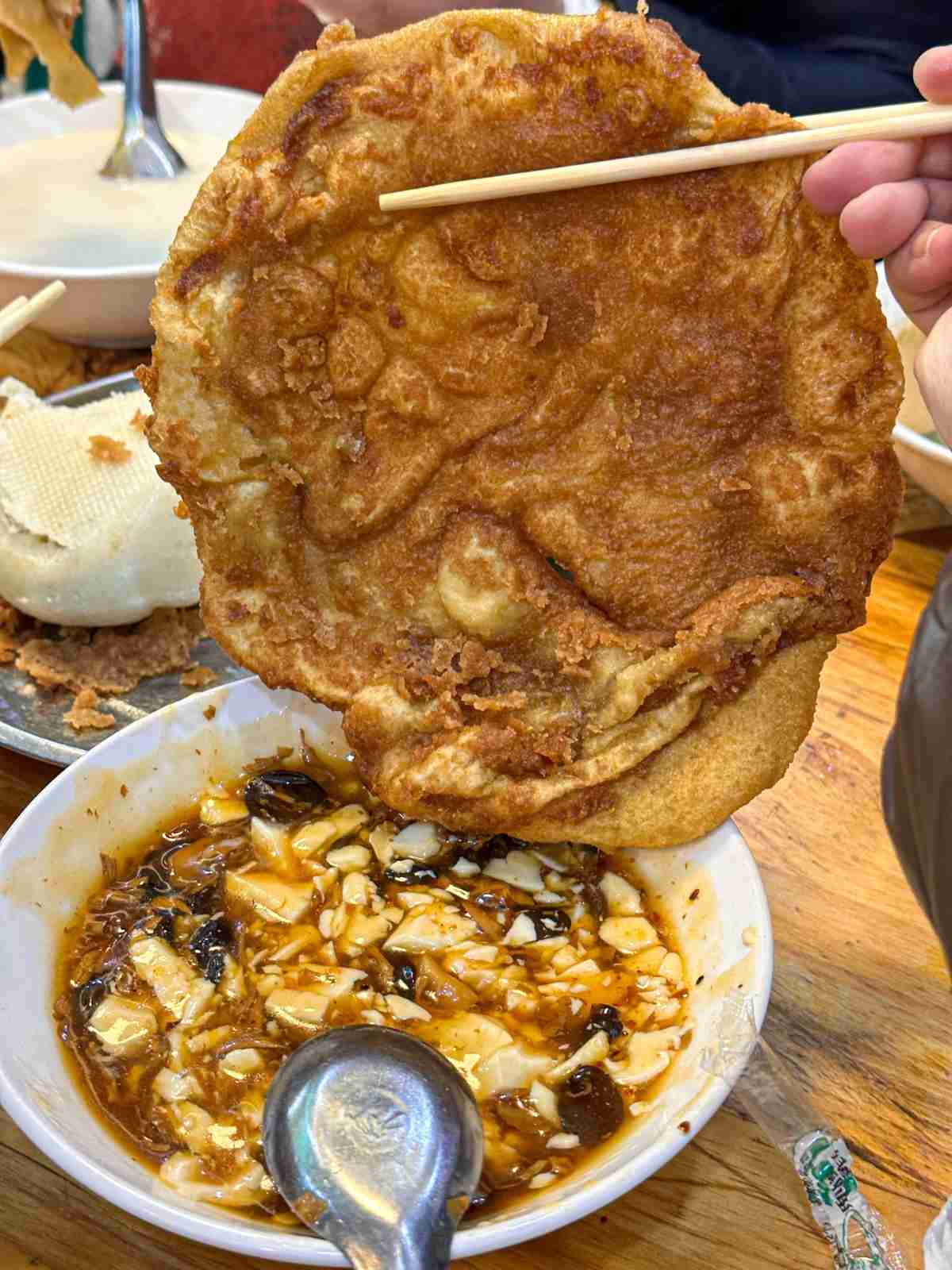
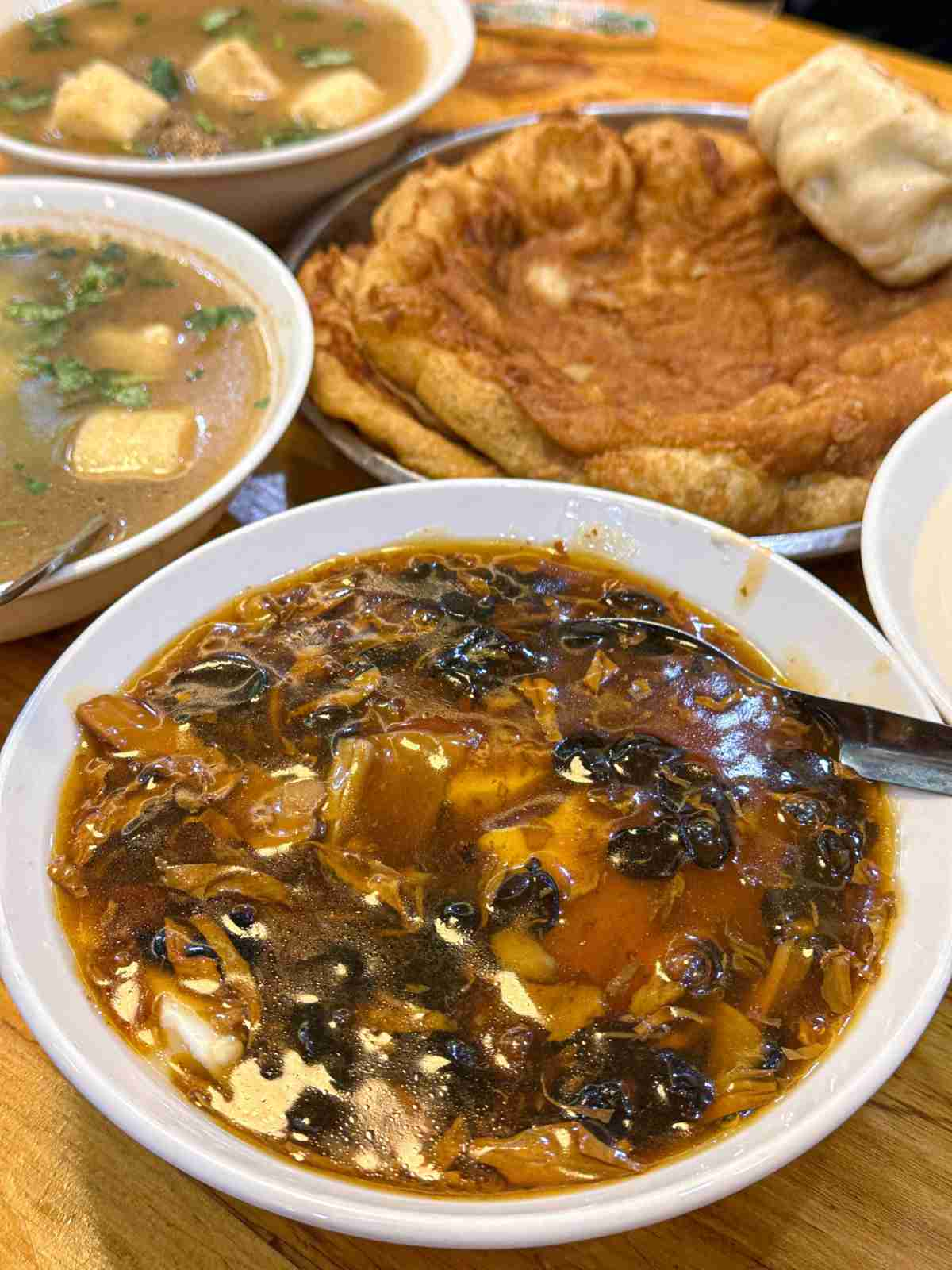
Sugar Pancake is a beloved snack originating from Beijing. It is made mainly with flour, sugar, and cooking oil, plus some alkaline water and a bit of salt.
The ingredients are mixed, proofed, and then thinly fried into cakes with a crispy texture and flaky layers.
When freshly fried, the cakes are hot, crispy, and oozing with oil fragrance. The perfect balance of sugar and oil makes them highly craveable.
The surface develops lovely crackling patterns during frying.
This street food originated in the Qing dynasty, first as a seasonal festive treat. It later became a daily breakfast and snack for Beijing locals.
Where to Try the Best Sugar Pancake in Beijing?
- HeiYao Chang Jie Tang YouBing: Crispy fried dough sticks served with sweet soybean pudding, a standard Beijing breakfast set.
- Zengshengkui Snack bar: The sugar is evenly distributed. Biting into it, the crispy fried dough reveals a soft and chewy texture inside, especially resilience to chewing.
Best Sugar Pancake Tours in Beijing
14.Beijing Crunchy Chips – 炸灌肠

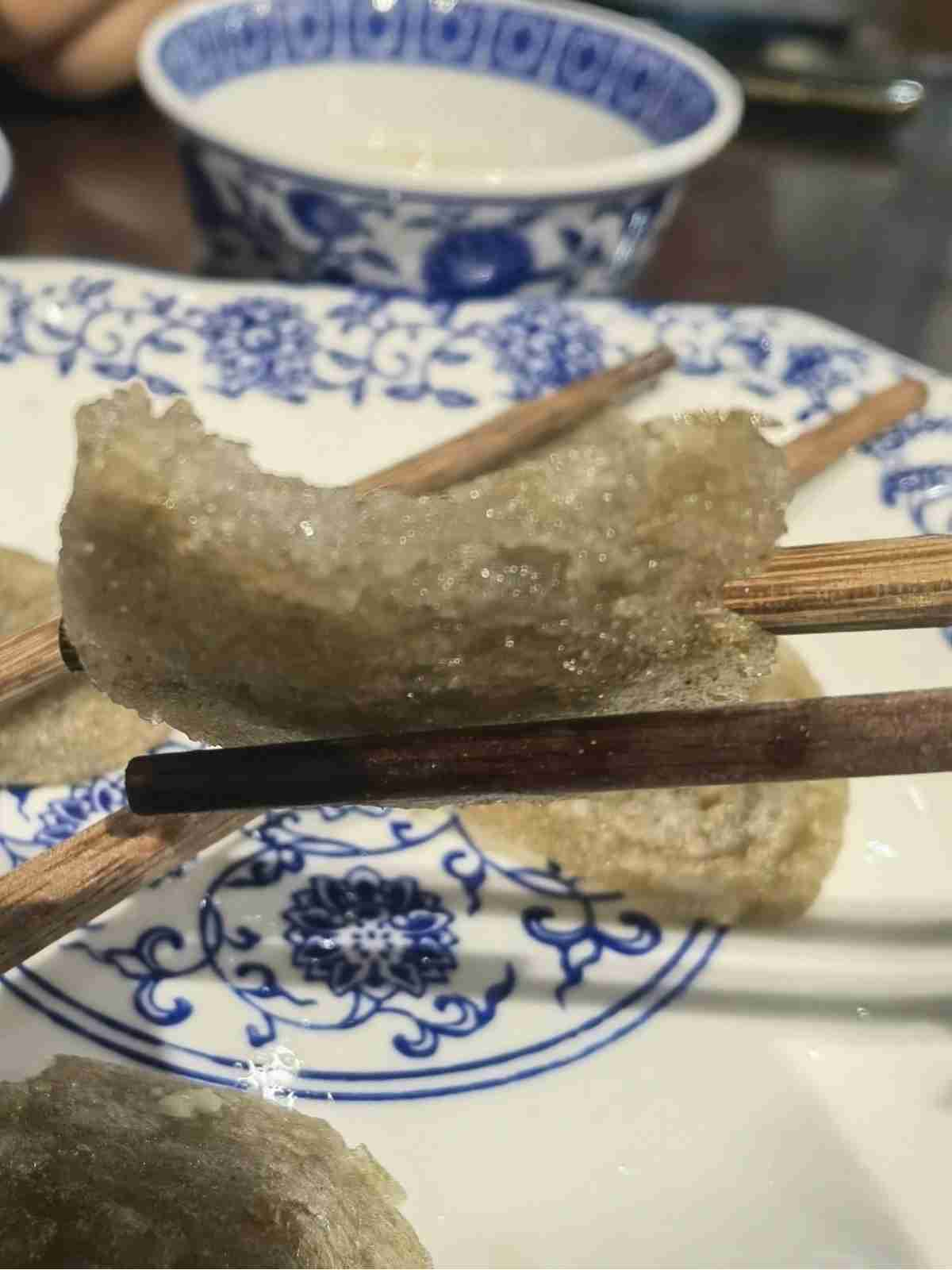
Beijing Crunchy Chips, called zhaguanchang in Chinese, the literal meaning of its name as deep-fried intestines, are actually deep-fried starch balls and contain no animal offal.
Many people are surprised by its name.
In fact, back in the Ming dynasty several hundred years ago, they were indeed made by stuffing pig intestines with starch and minced meat, and were already popular street food in Beijing at the time.
After hundreds of years of evolution, the main ingredients have changed and no longer contain pig intestines.However, lard is still used for deep frying, so it smells like pork.
Beijing Crunchy Chips taste delicious, especially when freshly fried with a crispy crust.
Dipped in salt water and garlic sauce, they have a contrasting crunchy exterior and soft interior.
Where to Try the Best Crunchy Chips in Beijing?
15.Beijing Craft Beer – 北京精酿啤酒
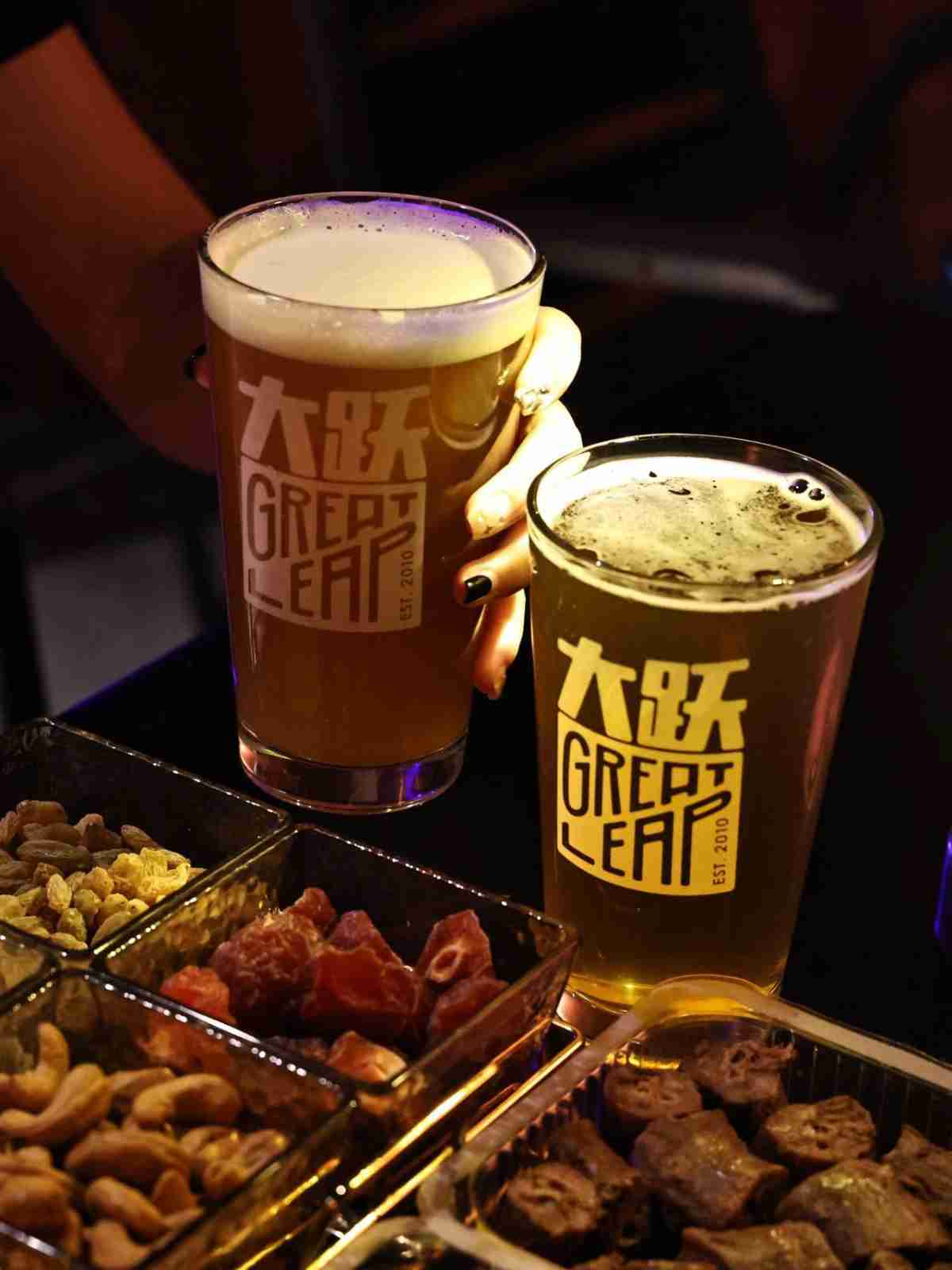
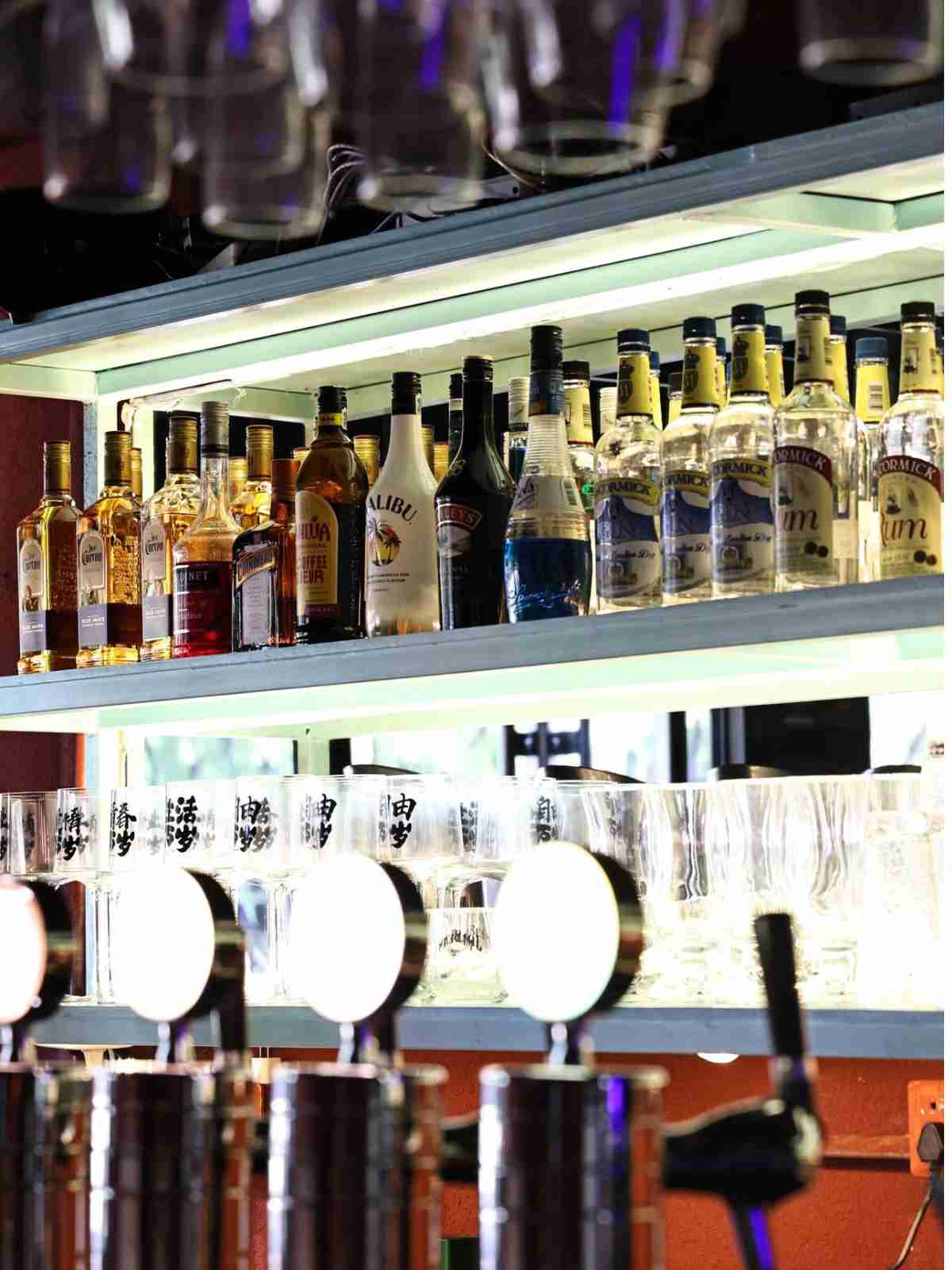
Beijing craft beer is a thriving scene, with a wide variety of breweries and bars to choose from.
The city is home to some of the most innovative and award-winning craft breweries in China, as well as a growing number of smaller, independent brewers.
Beijing craft beer is known for its diversity, with breweries producing everything from classic styles like pale ales and IPAs to more experimental brews using local ingredients like Sichuan peppercorns and oolong tea.
Some of the most popular Beijing craft beers include:
- Great Leap Brewing's Honey Ma Gold, a Sichuan peppercorn ale
- Jing-A Brewing's Duck Rye'der, a rye IPA
- Panda Brewpub's Panda Pale Ale, a classic American pale ale
- Slow Boat Brewery's Jade IPA, a juicy IPA with tropical fruit notes
- Boxing Cat Brewery's Mango Sour, a refreshing sour beer with mango puree
Where to Try the Best Craft Beer in Beijing?
- Great Leap Taproom: Beijing's first local craft beer brand, attracting many foreign customers every day.
- Peiping Machine Taphouse: Industrial architecture style, offering many different beer flavors: IPA, sour, stouts, porters etc.
- Jing A Brewpub: Aside from the beers, don't miss out on their French fries as well.
Best Craft Beer Tours in Beijing
16.Baozi and Mantou – 包子和馒头

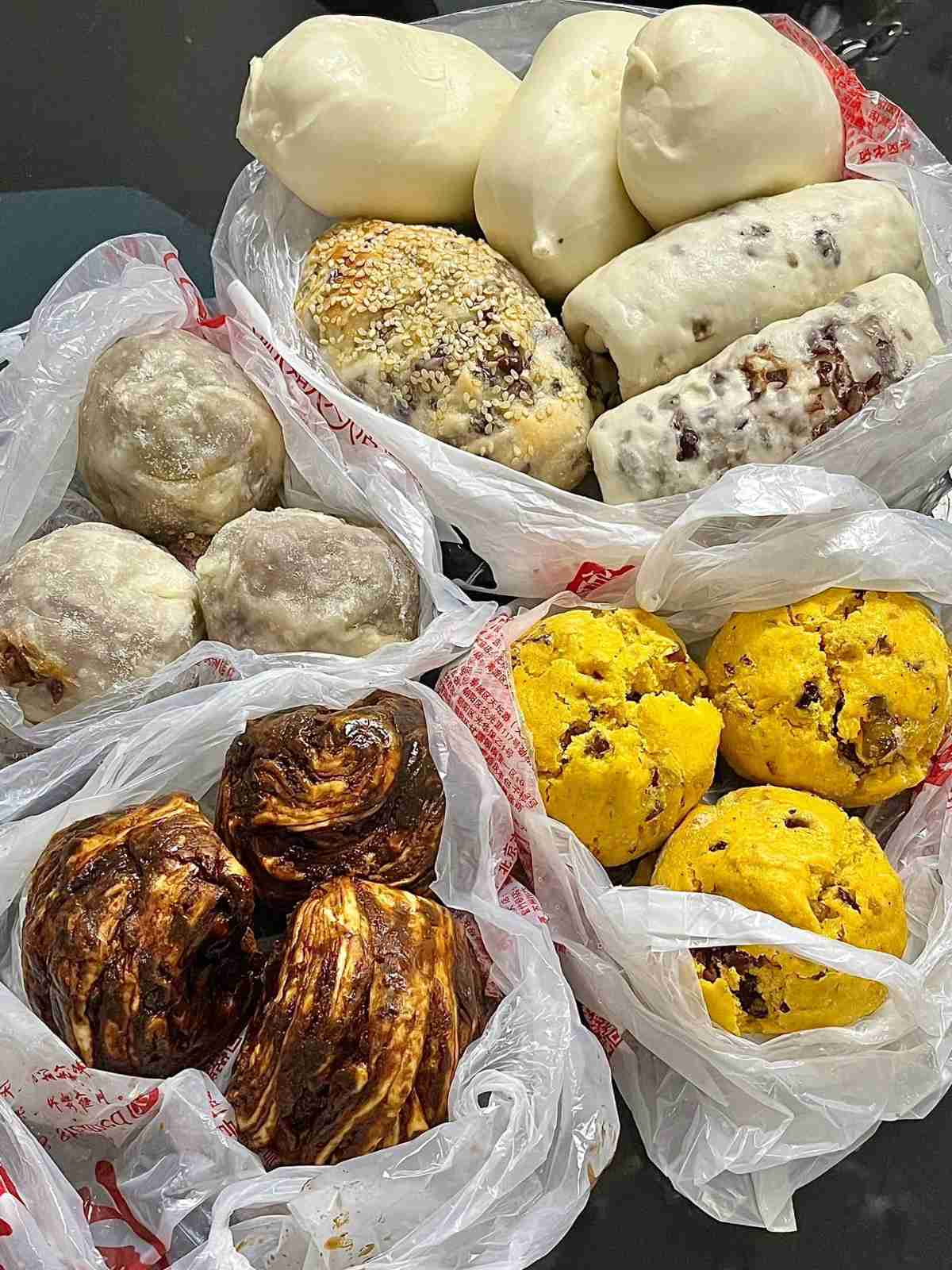
Baozi are steamed filled buns that are a signature breakfast item in Beijing. The soft white dough buns are filled with ingredients like minced pork, vegetables, red bean paste etc.
One of the most famous steamed dumpling shops is Qingfeng Baozipu. Founded in 1958, it is a state-owned enterprise in Beijing.
Qingfeng's signature baozi are the pork and green onion dumplings. They have thin skin and abundant fillings, with delicious flavors.
Mantou refers to plain steamed buns without any filling. The buns are made with flour, water and leavening, then steamed until puffed up.
Mantou are soft, pillowy and slightly sweet due to the natural fermentation. They are eaten as a carb-heavy breakfast item, sometimes with soy milk or stuffed with other ingredients.
But nowadays, there are many varieties of beijing baozi, no longer just plain white buns.
Where to Try the Best Baozi and Mantou in Beijing?
- QingFeng BaoZiPu: A famous baozi shop in Beijing, a state-owned enterprise.
- GongMenkou: Offers a wide variety of stuffed steamed mantou.
Best Breakfast Tours in Beijing
17.Doornail Meat Pie – 门钉肉饼
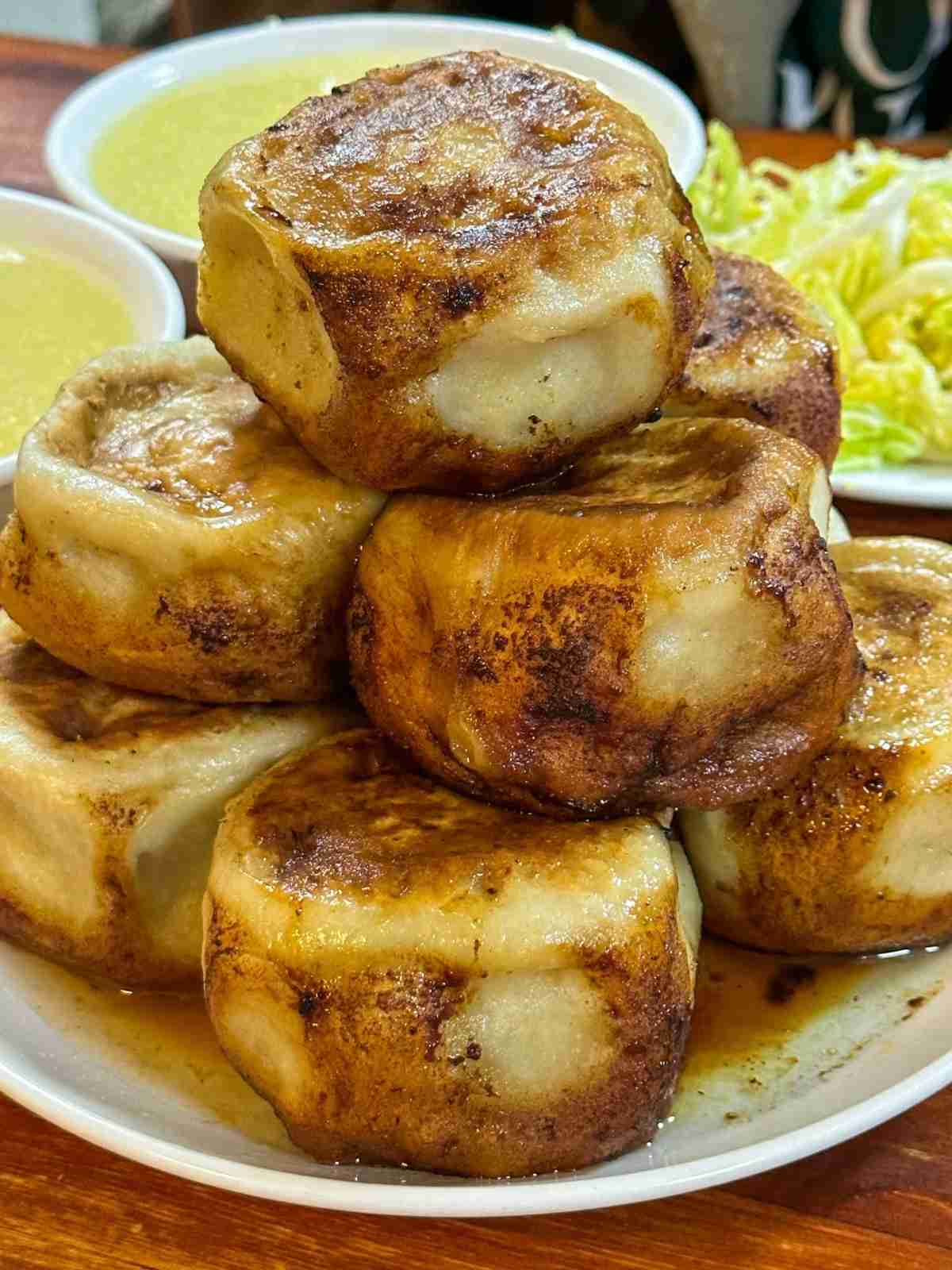

Doornail Meat Pie is a traditional Beijing snack made with a thin, doughy skin filled with a savory meat mixture.
The name “Doornail” refers to the shape of the pies, which are small and round, resembling the nail heads on the gates of ancient Chinese cities.
The pancake dough is made from high-gluten flour and stretched very thin like a huge flatbread. Shredded marinated pork and cabbage are placed on top, then the dough is folded over and sealed by pressing down with an engraved wooden door nail tool.
The stuffed dough parcel is baked piping hot in a clay oven, during which it puffs up. The exterior gets crispy, while the inside remains soft and fluffy.
Doornail Meat Pie is an on-the-go street food invented in Beijing over 300 years ago during the Qing dynasty. It was created as a tasty and portable hand-held meal.
Where to Try the Best Doornail Meat Pie in Beijing?
- Xiang Yunxuan: The top ranked Doornail Meat Pie shop in Beijing. Their pies have full and juicy fillings, very satisfying.
- BaoRui MenDing RouBing: A classic old shop with many locals coming to taste their pies everyday.
18.Old Beijing Milk Custard – 老北京奶酪
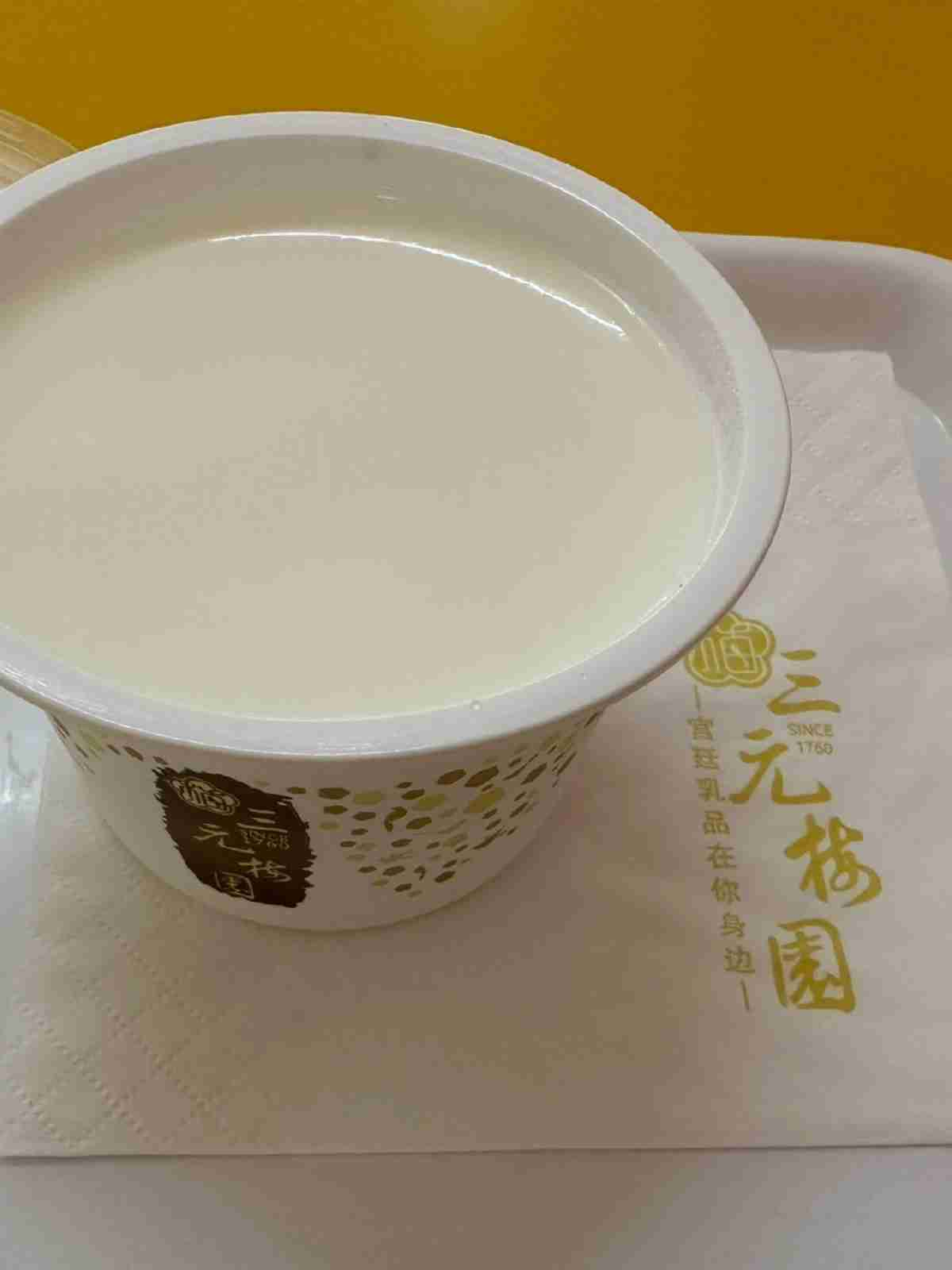

Old Beijing Milk Custard is a traditional Chinese dessert made with milk, rice wine, and sugar. It is a creamy, custard-like dish with a sweet and slightly alcoholic flavor.
The Milk Custard is believed to have originated in the Qing Dynasty. It was originally served as a delicacy in the imperial court, but it has since become a popular snack and dessert throughout China.
There are many different recipes for Old Beijing Cheese, but the basic ingredients are always the same. Milk is boiled and then mixed with rice wine and sugar. The mixture is then cooked in a double boiler until it thickens and sets.
Old Beijing Milk Custard can be served plain or topped with fruit, nuts, or other toppings. It is often eaten as a snack or dessert, or it can be used as a filling for pastries or other desserts.
Where to Try the Best Old Beijing Milk Custard in Beijing?
- Sanyuan Meiyuan: A former imperial cheese shop, providing consistent high quality for over a century.
- Wenyu Cheese Shop: Located in the bustling Nanluoguxiang Hutong, offering authentic and rich milk custard.
Best Food Markets in Beijing
The best way to explore the cuisines is to visit the local food streets. Beijing has several snack streets that are also famous tourist attractions.
In these places, you can often uncover hidden gems.
Nanluoguxiang Hutong
A pedestrian street transformed from Beijing's old city blocks, bustling day and night, with all kinds of snack shops, cafes and bars.
Qianmen Street
Located in central Beijing, close to attractions like the Forbidden City and Tiananmen Square, it is a popular area for first-time visitors.
Aside from the sprawling food destination pieced together from several blocks, there are also abundant entertainment options – Beijing Opera, acrobatics, Cross talk, etc.
Also an ideal area to stay.
Wangfujing Snack Street
A more international area with cuisines from around the world, including Thai, Malaysian, Korean and more, in addition to local Chinese specialties.
Also a good place for shopping.
Guang’anmen Food Street
Located in the south of the city, this night market boasts a lot of Sichuan food, known for its heat and spice.
Best Food Tours in Beijing
If you don't speak Chinese and it's your first time in China, the best option is to hire a private tour guide or join a tour group.
The unfamiliarity can be daunting, right?
Having a knowledgeable local guide who can speak your language will make getting around and communicating so much easier. They can explain customs, recommend places to eat, negotiate prices, and prevent you from getting scammed.
Tour groups are great for meeting other travelers and learning in a group setting.
1. Book a Private Tour on Viator
Viator can offer very affordable prices and has a huge variety of options.
Here are some top food tour picks:
2. Lost Plate Food Tour
Lost Plate is an amazing food tour company that offers tours in Beijing, Shanghai, Chengdu, Xi’an and recently, Cambodia and Portland!
This is the tour where you’ll have a chance to try the Emperor’s Pork Pancake, along with a few other delicacies like alcoholic yogurt, sesame noodles, Mongolian BBQ, and more!
You’ll also end the tour at a local Beijing craft brewery, Arrow Factory!
3. UnTour Food Tour
UnTour is another great private food tour company in China that promises to make you “eat like a local.”
They carefully curate dishes based on your group size and dietary needs so that there is no waste or discomfort with the food.
If you want an authentic food tour experience like you're with a real Chinese friend, don't miss UnTour.
FAQs
What Are Beijing Traditional Cuisine?
1.Peking duck – 北京烤鸭
2.Mongolian Hot Pot – 铜锅涮肉
3.Beijing Donkey Roll – 驴打滚
4.Beijing Luzhu- 卤煮
5.Donkey Burger- 驴肉火烧
6.Chaogan – 炒肝
7.Douzhi And Madoufu – 豆汁和麻豆腐
8.Beijing Crunchy Chips – 炸灌肠
9.Doornail Meat Pie – 门钉肉饼
10.Old Beijing Milk Custard – 老北京奶酪
What Are Beijing's Most Famous Foods?
Beijing roasted duck is one of the most iconic dishes of the city with a history of over 600 years. The thin pancakes, sweet bean sauce, scallions and tender duck meat cooked to crispy perfection make it a must-try for any visitor.
Peking duck is almost synonymous with Beijing.
How Much Is Chinese Food in Beijing?
Here is a rough guide to the cost of Chinese food in Beijing:
Budget restaurants: A meal at a budget restaurant in Beijing will typically cost around 20-30 yuan ($3-$4 USD) per person. This will include a main dish, rice, and soup.
Mid-range restaurants: A meal at a mid-range restaurant in Beijing will typically cost around 50-100 yuan ($7-$14 USD) per person. This will include a variety of dishes, such as appetizers, main courses, and vegetables.
High-end restaurants: A meal at a high-end restaurant in Beijing can cost upwards of 200 yuan ($30 USD) per person. This will include a variety of dishes, as well as drinks and dessert.
Here are some examples of popular Chinese dishes and their prices in Beijing:
Noodles: 15-20 yuan ($2-$3 USD)
Fried rice: 15-20 yuan ($2-$3 USD)
Dumplings: 10-15 yuan ($1.50-$2 USD) per order
Stir-fries: 20-30 yuan ($3-$4 USD) per dish
Roast duck: 200-300 yuan ($30-$45 USD) for a whole duck
